Biological Principles for Pharmacy Technicians: Carbohydrates, Lipids, Proteins, and Enzymes
VerifiedAdded on 2023/06/17
|24
|5029
|75
AI Summary
This assessment focuses on enhancing the knowledge of trainee pharmacy technicians about the importance of lipids, carbohydrates, proteins, and enzymes in the human body. It covers the structure and functions of these biological molecules and their role in growth, repair, and energy production. The assessment also includes a detailed explanation of the structure and functions of enzymes and their role in catalyzing chemical reactions in the body.
Contribute Materials
Your contribution can guide someone’s learning journey. Share your
documents today.
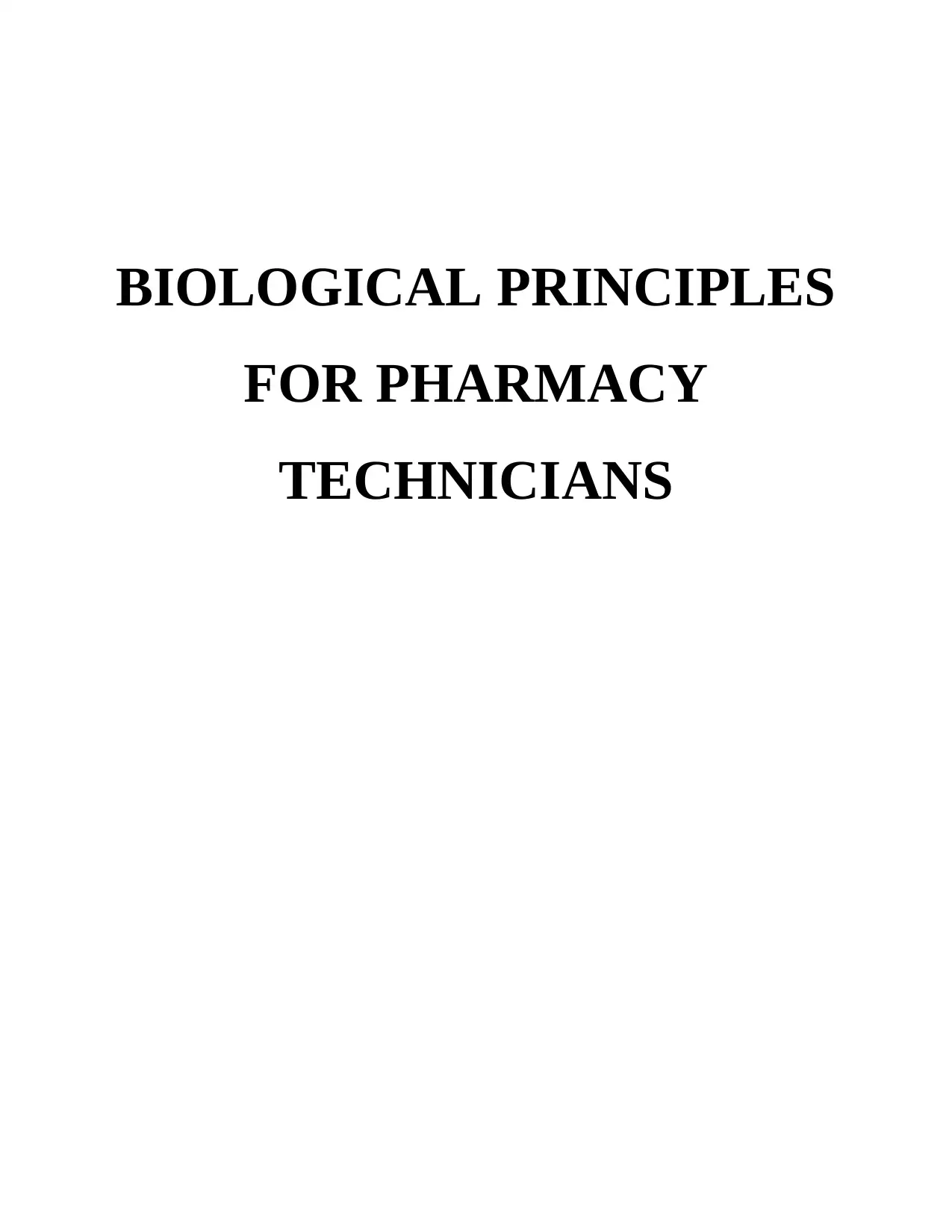
BIOLOGICAL PRINCIPLES
FOR PHARMACY
TECHNICIANS
FOR PHARMACY
TECHNICIANS
Secure Best Marks with AI Grader
Need help grading? Try our AI Grader for instant feedback on your assignments.
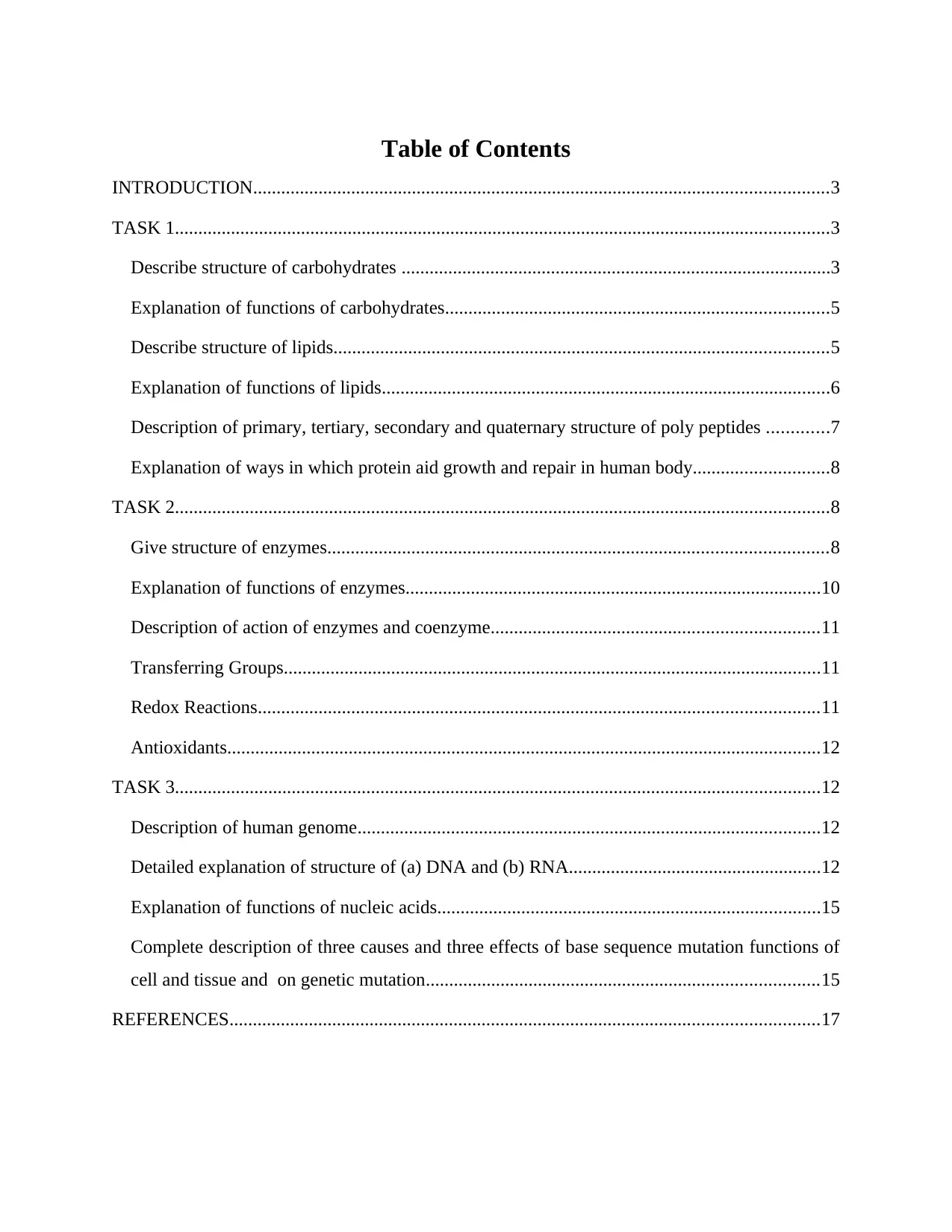
Table of Contents
INTRODUCTION...........................................................................................................................3
TASK 1............................................................................................................................................3
Describe structure of carbohydrates ............................................................................................3
Explanation of functions of carbohydrates..................................................................................5
Describe structure of lipids..........................................................................................................5
Explanation of functions of lipids................................................................................................6
Description of primary, tertiary, secondary and quaternary structure of poly peptides .............7
Explanation of ways in which protein aid growth and repair in human body.............................8
TASK 2............................................................................................................................................8
Give structure of enzymes...........................................................................................................8
Explanation of functions of enzymes.........................................................................................10
Description of action of enzymes and coenzyme......................................................................11
Transferring Groups...................................................................................................................11
Redox Reactions........................................................................................................................11
Antioxidants...............................................................................................................................12
TASK 3..........................................................................................................................................12
Description of human genome...................................................................................................12
Detailed explanation of structure of (a) DNA and (b) RNA......................................................12
Explanation of functions of nucleic acids..................................................................................15
Complete description of three causes and three effects of base sequence mutation functions of
cell and tissue and on genetic mutation....................................................................................15
REFERENCES..............................................................................................................................17
INTRODUCTION...........................................................................................................................3
TASK 1............................................................................................................................................3
Describe structure of carbohydrates ............................................................................................3
Explanation of functions of carbohydrates..................................................................................5
Describe structure of lipids..........................................................................................................5
Explanation of functions of lipids................................................................................................6
Description of primary, tertiary, secondary and quaternary structure of poly peptides .............7
Explanation of ways in which protein aid growth and repair in human body.............................8
TASK 2............................................................................................................................................8
Give structure of enzymes...........................................................................................................8
Explanation of functions of enzymes.........................................................................................10
Description of action of enzymes and coenzyme......................................................................11
Transferring Groups...................................................................................................................11
Redox Reactions........................................................................................................................11
Antioxidants...............................................................................................................................12
TASK 3..........................................................................................................................................12
Description of human genome...................................................................................................12
Detailed explanation of structure of (a) DNA and (b) RNA......................................................12
Explanation of functions of nucleic acids..................................................................................15
Complete description of three causes and three effects of base sequence mutation functions of
cell and tissue and on genetic mutation....................................................................................15
REFERENCES..............................................................................................................................17
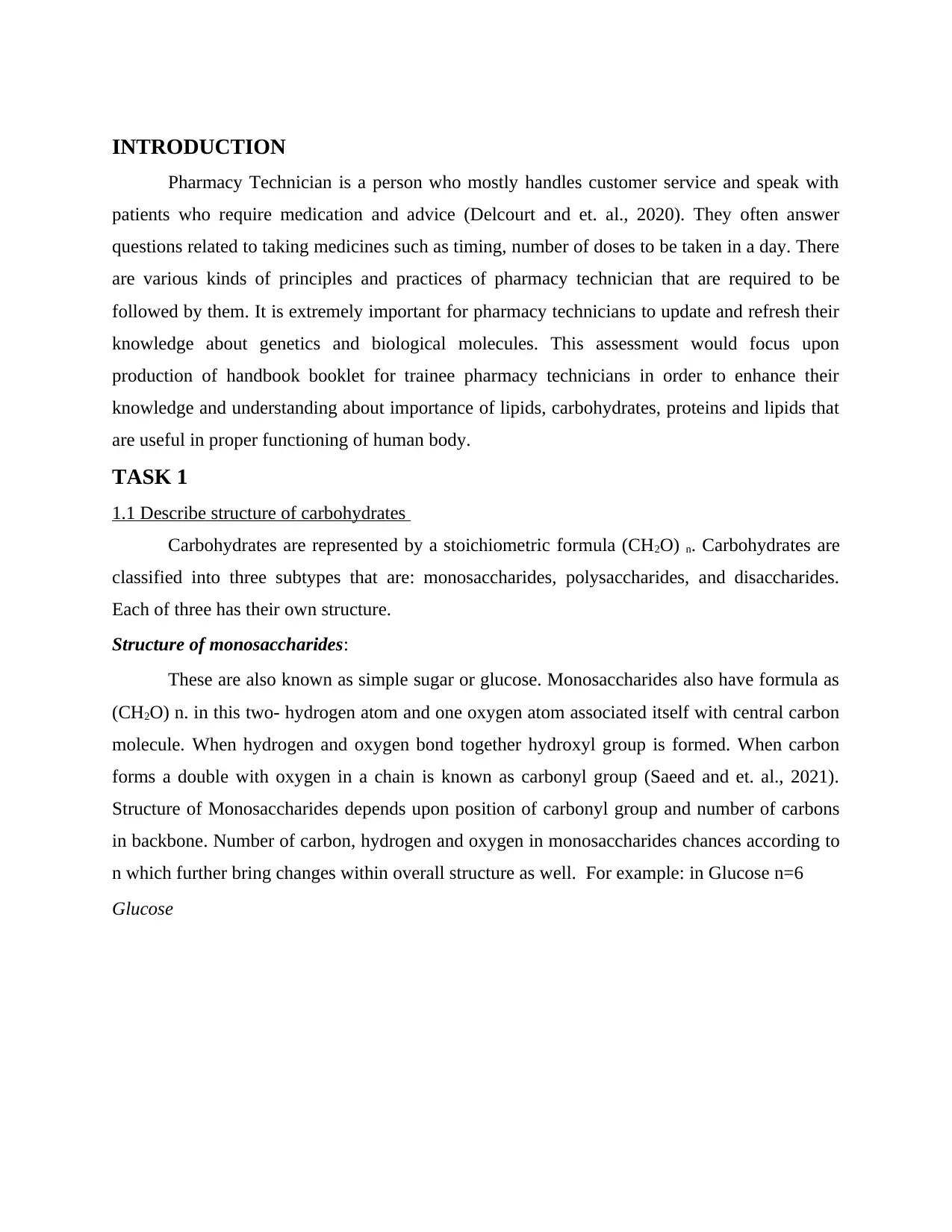
INTRODUCTION
Pharmacy Technician is a person who mostly handles customer service and speak with
patients who require medication and advice (Delcourt and et. al., 2020). They often answer
questions related to taking medicines such as timing, number of doses to be taken in a day. There
are various kinds of principles and practices of pharmacy technician that are required to be
followed by them. It is extremely important for pharmacy technicians to update and refresh their
knowledge about genetics and biological molecules. This assessment would focus upon
production of handbook booklet for trainee pharmacy technicians in order to enhance their
knowledge and understanding about importance of lipids, carbohydrates, proteins and lipids that
are useful in proper functioning of human body.
TASK 1
1.1 Describe structure of carbohydrates
Carbohydrates are represented by a stoichiometric formula (CH2O) n. Carbohydrates are
classified into three subtypes that are: monosaccharides, polysaccharides, and disaccharides.
Each of three has their own structure.
Structure of monosaccharides:
These are also known as simple sugar or glucose. Monosaccharides also have formula as
(CH2O) n. in this two- hydrogen atom and one oxygen atom associated itself with central carbon
molecule. When hydrogen and oxygen bond together hydroxyl group is formed. When carbon
forms a double with oxygen in a chain is known as carbonyl group (Saeed and et. al., 2021).
Structure of Monosaccharides depends upon position of carbonyl group and number of carbons
in backbone. Number of carbon, hydrogen and oxygen in monosaccharides chances according to
n which further bring changes within overall structure as well. For example: in Glucose n=6
Glucose
Pharmacy Technician is a person who mostly handles customer service and speak with
patients who require medication and advice (Delcourt and et. al., 2020). They often answer
questions related to taking medicines such as timing, number of doses to be taken in a day. There
are various kinds of principles and practices of pharmacy technician that are required to be
followed by them. It is extremely important for pharmacy technicians to update and refresh their
knowledge about genetics and biological molecules. This assessment would focus upon
production of handbook booklet for trainee pharmacy technicians in order to enhance their
knowledge and understanding about importance of lipids, carbohydrates, proteins and lipids that
are useful in proper functioning of human body.
TASK 1
1.1 Describe structure of carbohydrates
Carbohydrates are represented by a stoichiometric formula (CH2O) n. Carbohydrates are
classified into three subtypes that are: monosaccharides, polysaccharides, and disaccharides.
Each of three has their own structure.
Structure of monosaccharides:
These are also known as simple sugar or glucose. Monosaccharides also have formula as
(CH2O) n. in this two- hydrogen atom and one oxygen atom associated itself with central carbon
molecule. When hydrogen and oxygen bond together hydroxyl group is formed. When carbon
forms a double with oxygen in a chain is known as carbonyl group (Saeed and et. al., 2021).
Structure of Monosaccharides depends upon position of carbonyl group and number of carbons
in backbone. Number of carbon, hydrogen and oxygen in monosaccharides chances according to
n which further bring changes within overall structure as well. For example: in Glucose n=6
Glucose

Ketose
Structure of disaccharides:
When two Monosaccharides are formed and linked together then it is known as
disaccharides. These two Monosaccharides can be different and can be linked with the help of an
oxygen atom. Different types of disaccharides are have different structure and it depends upon
types of monosaccharides that are being linked together. One of the most common example of
disaccharides is sucrose in which on hydrolysis D -(+)- glucose and D-(-)- fructose are given.
Structure of sucrose have been provided below:
Structure of disaccharides:
When two Monosaccharides are formed and linked together then it is known as
disaccharides. These two Monosaccharides can be different and can be linked with the help of an
oxygen atom. Different types of disaccharides are have different structure and it depends upon
types of monosaccharides that are being linked together. One of the most common example of
disaccharides is sucrose in which on hydrolysis D -(+)- glucose and D-(-)- fructose are given.
Structure of sucrose have been provided below:
Secure Best Marks with AI Grader
Need help grading? Try our AI Grader for instant feedback on your assignments.
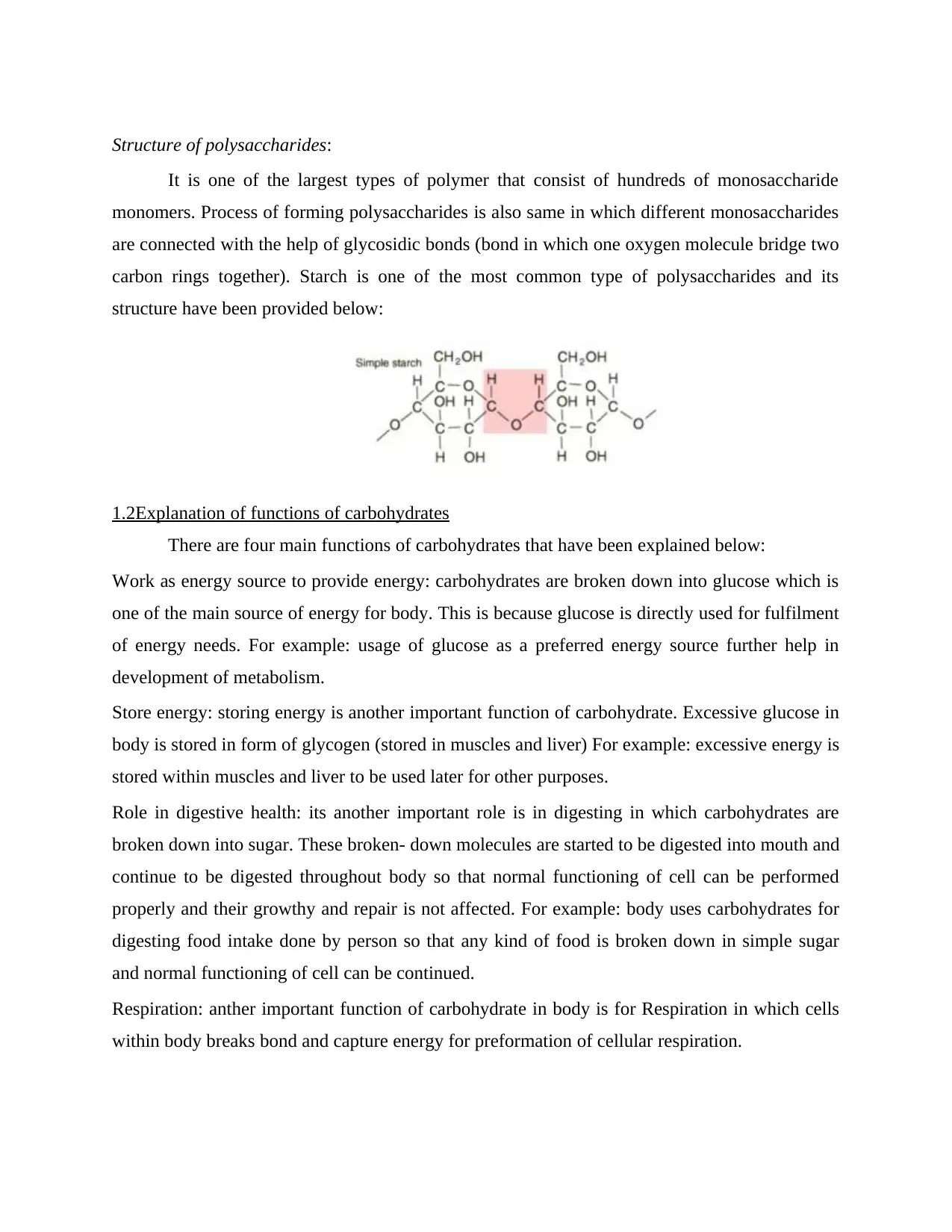
Structure of polysaccharides:
It is one of the largest types of polymer that consist of hundreds of monosaccharide
monomers. Process of forming polysaccharides is also same in which different monosaccharides
are connected with the help of glycosidic bonds (bond in which one oxygen molecule bridge two
carbon rings together). Starch is one of the most common type of polysaccharides and its
structure have been provided below:
1.2Explanation of functions of carbohydrates
There are four main functions of carbohydrates that have been explained below:
Work as energy source to provide energy: carbohydrates are broken down into glucose which is
one of the main source of energy for body. This is because glucose is directly used for fulfilment
of energy needs. For example: usage of glucose as a preferred energy source further help in
development of metabolism.
Store energy: storing energy is another important function of carbohydrate. Excessive glucose in
body is stored in form of glycogen (stored in muscles and liver) For example: excessive energy is
stored within muscles and liver to be used later for other purposes.
Role in digestive health: its another important role is in digesting in which carbohydrates are
broken down into sugar. These broken- down molecules are started to be digested into mouth and
continue to be digested throughout body so that normal functioning of cell can be performed
properly and their growthy and repair is not affected. For example: body uses carbohydrates for
digesting food intake done by person so that any kind of food is broken down in simple sugar
and normal functioning of cell can be continued.
Respiration: anther important function of carbohydrate in body is for Respiration in which cells
within body breaks bond and capture energy for preformation of cellular respiration.
It is one of the largest types of polymer that consist of hundreds of monosaccharide
monomers. Process of forming polysaccharides is also same in which different monosaccharides
are connected with the help of glycosidic bonds (bond in which one oxygen molecule bridge two
carbon rings together). Starch is one of the most common type of polysaccharides and its
structure have been provided below:
1.2Explanation of functions of carbohydrates
There are four main functions of carbohydrates that have been explained below:
Work as energy source to provide energy: carbohydrates are broken down into glucose which is
one of the main source of energy for body. This is because glucose is directly used for fulfilment
of energy needs. For example: usage of glucose as a preferred energy source further help in
development of metabolism.
Store energy: storing energy is another important function of carbohydrate. Excessive glucose in
body is stored in form of glycogen (stored in muscles and liver) For example: excessive energy is
stored within muscles and liver to be used later for other purposes.
Role in digestive health: its another important role is in digesting in which carbohydrates are
broken down into sugar. These broken- down molecules are started to be digested into mouth and
continue to be digested throughout body so that normal functioning of cell can be performed
properly and their growthy and repair is not affected. For example: body uses carbohydrates for
digesting food intake done by person so that any kind of food is broken down in simple sugar
and normal functioning of cell can be continued.
Respiration: anther important function of carbohydrate in body is for Respiration in which cells
within body breaks bond and capture energy for preformation of cellular respiration.
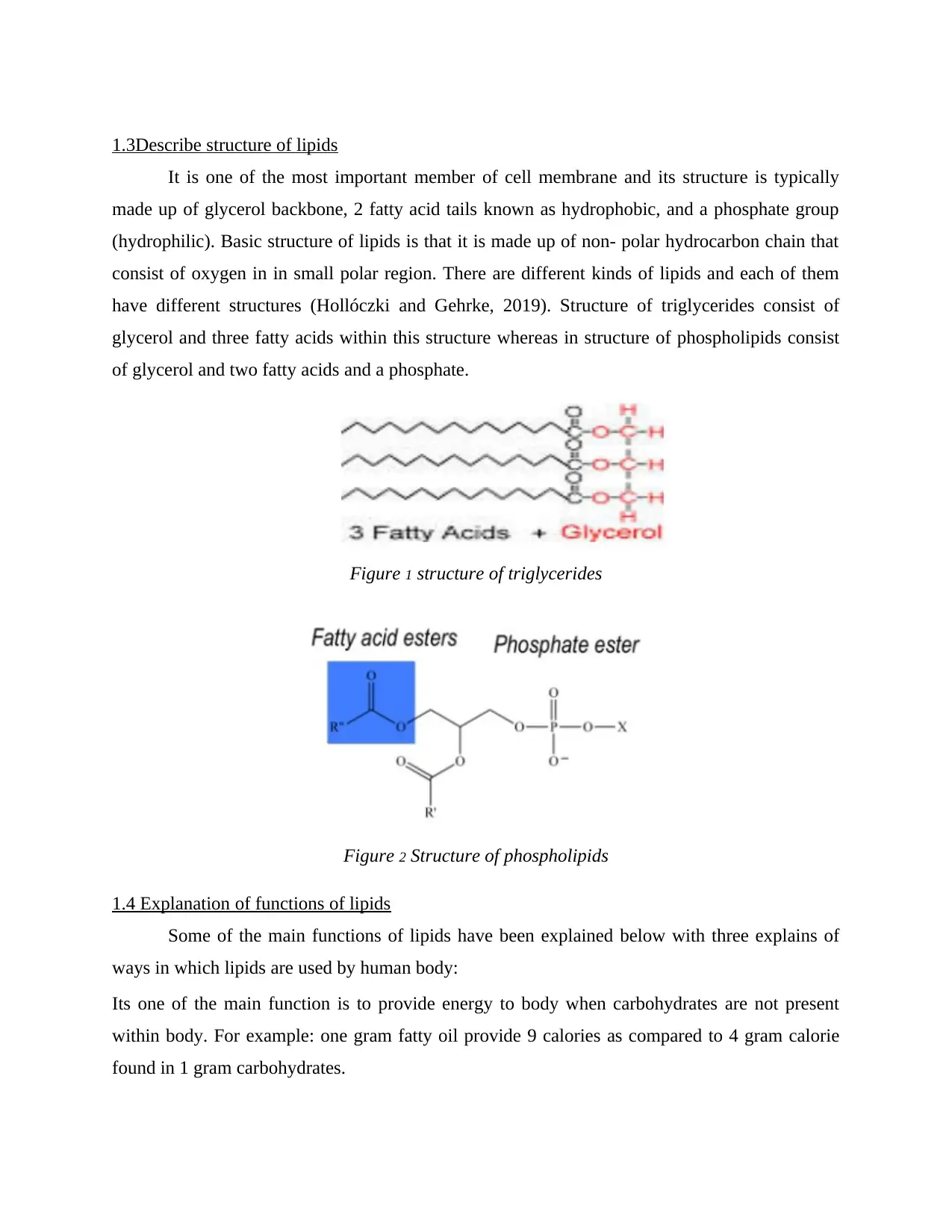
1.3Describe structure of lipids
It is one of the most important member of cell membrane and its structure is typically
made up of glycerol backbone, 2 fatty acid tails known as hydrophobic, and a phosphate group
(hydrophilic). Basic structure of lipids is that it is made up of non- polar hydrocarbon chain that
consist of oxygen in in small polar region. There are different kinds of lipids and each of them
have different structures (Hollóczki and Gehrke, 2019). Structure of triglycerides consist of
glycerol and three fatty acids within this structure whereas in structure of phospholipids consist
of glycerol and two fatty acids and a phosphate.
Figure 1 structure of triglycerides
Figure 2 Structure of phospholipids
1.4 Explanation of functions of lipids
Some of the main functions of lipids have been explained below with three explains of
ways in which lipids are used by human body:
Its one of the main function is to provide energy to body when carbohydrates are not present
within body. For example: one gram fatty oil provide 9 calories as compared to 4 gram calorie
found in 1 gram carbohydrates.
It is one of the most important member of cell membrane and its structure is typically
made up of glycerol backbone, 2 fatty acid tails known as hydrophobic, and a phosphate group
(hydrophilic). Basic structure of lipids is that it is made up of non- polar hydrocarbon chain that
consist of oxygen in in small polar region. There are different kinds of lipids and each of them
have different structures (Hollóczki and Gehrke, 2019). Structure of triglycerides consist of
glycerol and three fatty acids within this structure whereas in structure of phospholipids consist
of glycerol and two fatty acids and a phosphate.
Figure 1 structure of triglycerides
Figure 2 Structure of phospholipids
1.4 Explanation of functions of lipids
Some of the main functions of lipids have been explained below with three explains of
ways in which lipids are used by human body:
Its one of the main function is to provide energy to body when carbohydrates are not present
within body. For example: one gram fatty oil provide 9 calories as compared to 4 gram calorie
found in 1 gram carbohydrates.
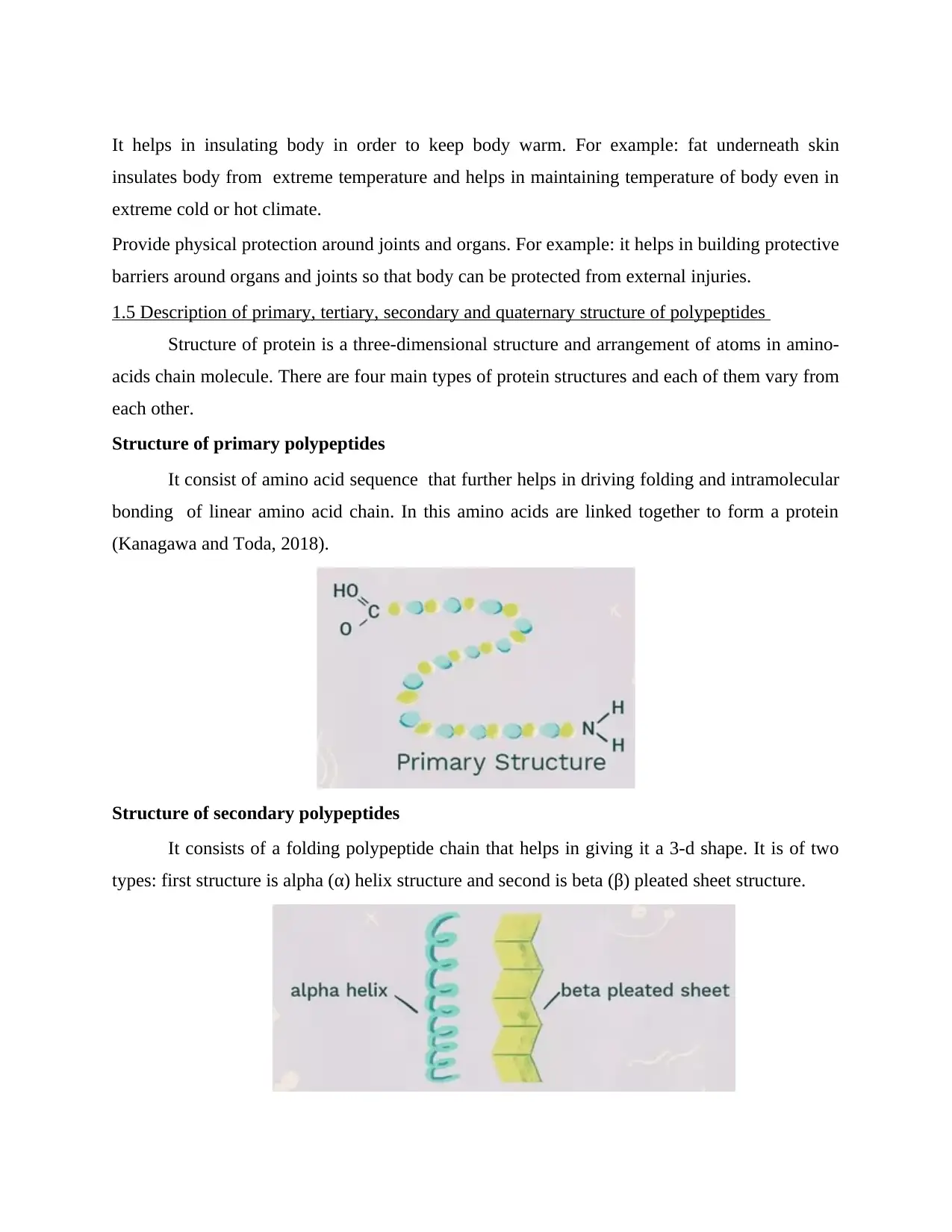
It helps in insulating body in order to keep body warm. For example: fat underneath skin
insulates body from extreme temperature and helps in maintaining temperature of body even in
extreme cold or hot climate.
Provide physical protection around joints and organs. For example: it helps in building protective
barriers around organs and joints so that body can be protected from external injuries.
1.5 Description of primary, tertiary, secondary and quaternary structure of polypeptides
Structure of protein is a three-dimensional structure and arrangement of atoms in amino-
acids chain molecule. There are four main types of protein structures and each of them vary from
each other.
Structure of primary polypeptides
It consist of amino acid sequence that further helps in driving folding and intramolecular
bonding of linear amino acid chain. In this amino acids are linked together to form a protein
(Kanagawa and Toda, 2018).
Structure of secondary polypeptides
It consists of a folding polypeptide chain that helps in giving it a 3-d shape. It is of two
types: first structure is alpha (α) helix structure and second is beta (β) pleated sheet structure.
insulates body from extreme temperature and helps in maintaining temperature of body even in
extreme cold or hot climate.
Provide physical protection around joints and organs. For example: it helps in building protective
barriers around organs and joints so that body can be protected from external injuries.
1.5 Description of primary, tertiary, secondary and quaternary structure of polypeptides
Structure of protein is a three-dimensional structure and arrangement of atoms in amino-
acids chain molecule. There are four main types of protein structures and each of them vary from
each other.
Structure of primary polypeptides
It consist of amino acid sequence that further helps in driving folding and intramolecular
bonding of linear amino acid chain. In this amino acids are linked together to form a protein
(Kanagawa and Toda, 2018).
Structure of secondary polypeptides
It consists of a folding polypeptide chain that helps in giving it a 3-d shape. It is of two
types: first structure is alpha (α) helix structure and second is beta (β) pleated sheet structure.
Paraphrase This Document
Need a fresh take? Get an instant paraphrase of this document with our AI Paraphraser
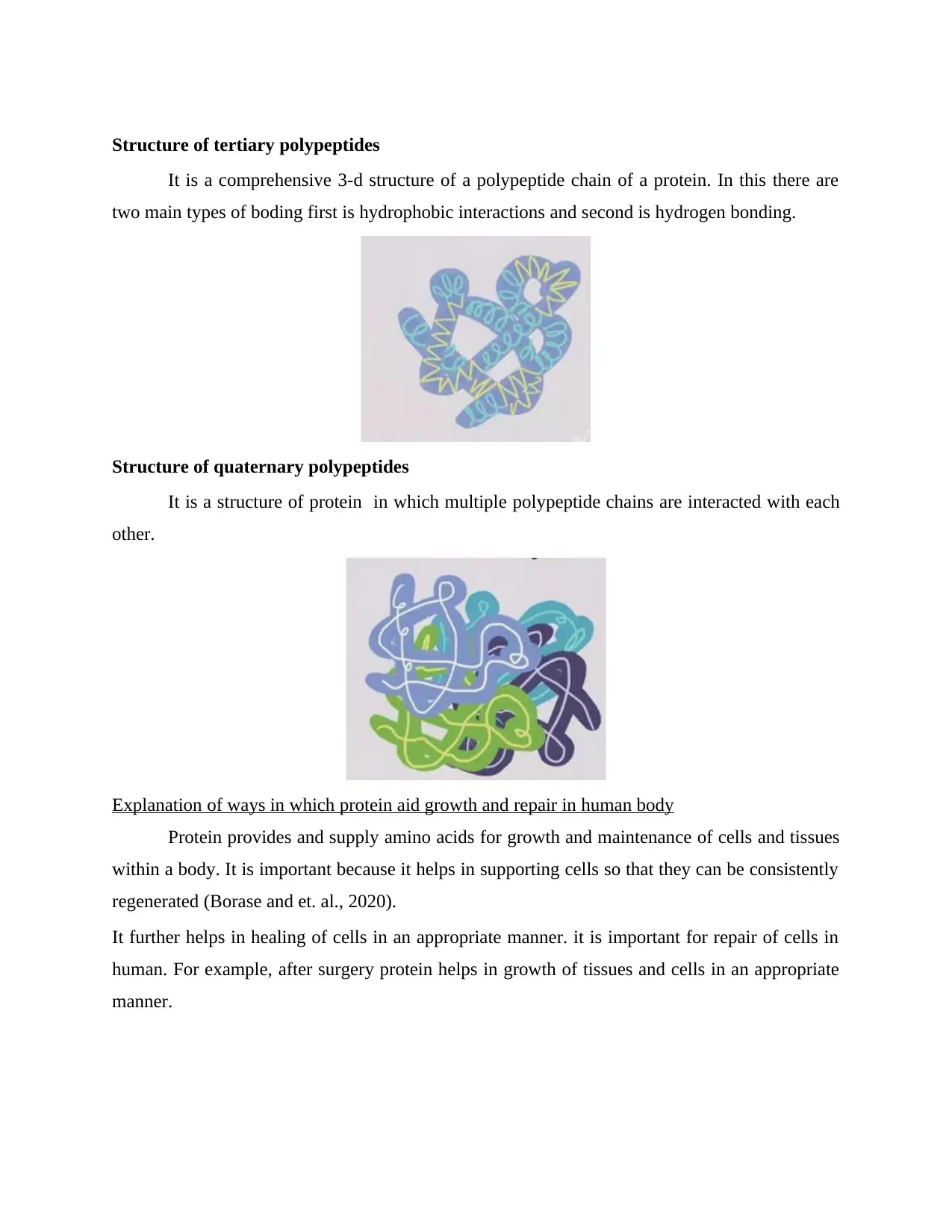
Structure of tertiary polypeptides
It is a comprehensive 3-d structure of a polypeptide chain of a protein. In this there are
two main types of boding first is hydrophobic interactions and second is hydrogen bonding.
Structure of quaternary polypeptides
It is a structure of protein in which multiple polypeptide chains are interacted with each
other.
Explanation of ways in which protein aid growth and repair in human body
Protein provides and supply amino acids for growth and maintenance of cells and tissues
within a body. It is important because it helps in supporting cells so that they can be consistently
regenerated (Borase and et. al., 2020).
It further helps in healing of cells in an appropriate manner. it is important for repair of cells in
human. For example, after surgery protein helps in growth of tissues and cells in an appropriate
manner.
It is a comprehensive 3-d structure of a polypeptide chain of a protein. In this there are
two main types of boding first is hydrophobic interactions and second is hydrogen bonding.
Structure of quaternary polypeptides
It is a structure of protein in which multiple polypeptide chains are interacted with each
other.
Explanation of ways in which protein aid growth and repair in human body
Protein provides and supply amino acids for growth and maintenance of cells and tissues
within a body. It is important because it helps in supporting cells so that they can be consistently
regenerated (Borase and et. al., 2020).
It further helps in healing of cells in an appropriate manner. it is important for repair of cells in
human. For example, after surgery protein helps in growth of tissues and cells in an appropriate
manner.
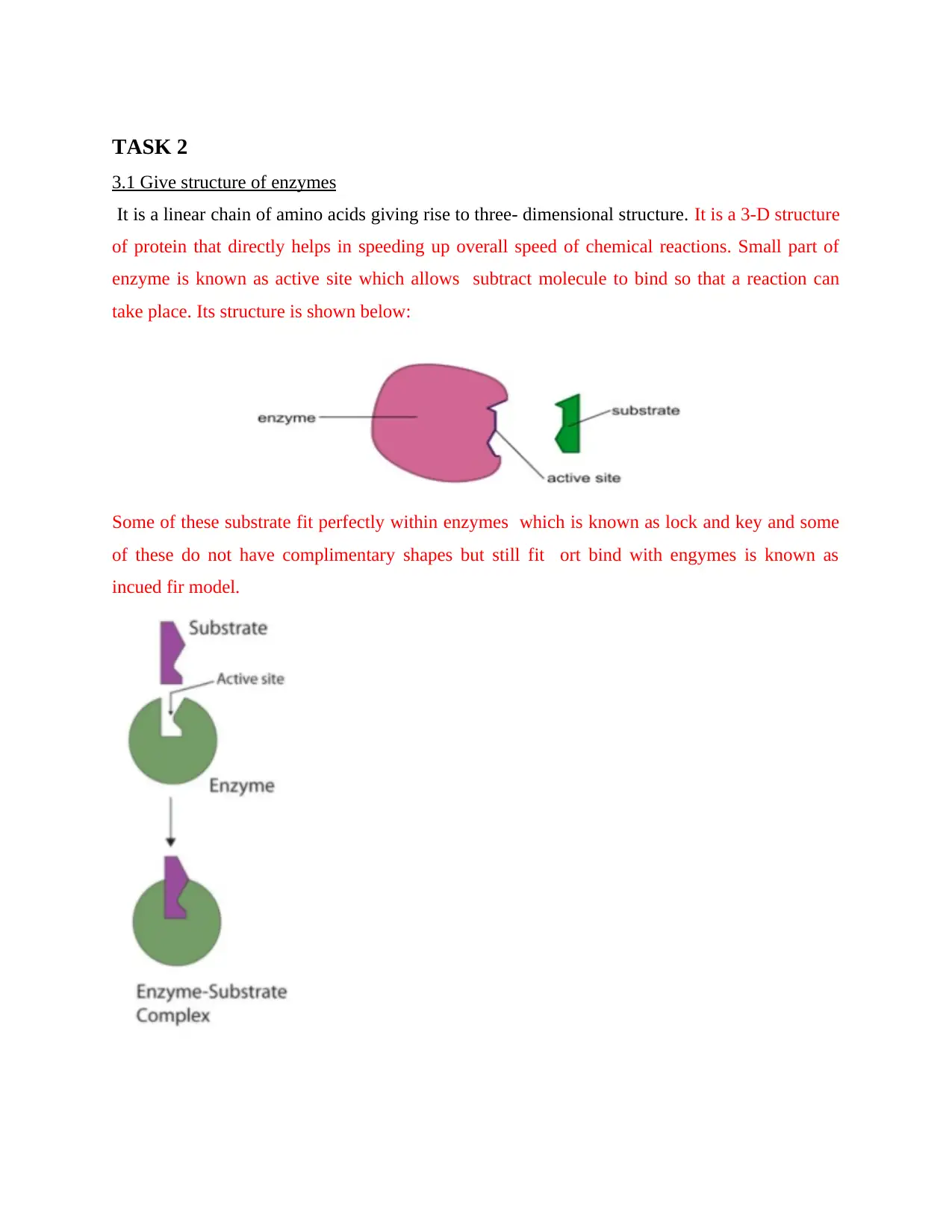
TASK 2
3.1 Give structure of enzymes
It is a linear chain of amino acids giving rise to three- dimensional structure. It is a 3-D structure
of protein that directly helps in speeding up overall speed of chemical reactions. Small part of
enzyme is known as active site which allows subtract molecule to bind so that a reaction can
take place. Its structure is shown below:
Some of these substrate fit perfectly within enzymes which is known as lock and key and some
of these do not have complimentary shapes but still fit ort bind with engymes is known as
incued fir model.
3.1 Give structure of enzymes
It is a linear chain of amino acids giving rise to three- dimensional structure. It is a 3-D structure
of protein that directly helps in speeding up overall speed of chemical reactions. Small part of
enzyme is known as active site which allows subtract molecule to bind so that a reaction can
take place. Its structure is shown below:
Some of these substrate fit perfectly within enzymes which is known as lock and key and some
of these do not have complimentary shapes but still fit ort bind with engymes is known as
incued fir model.
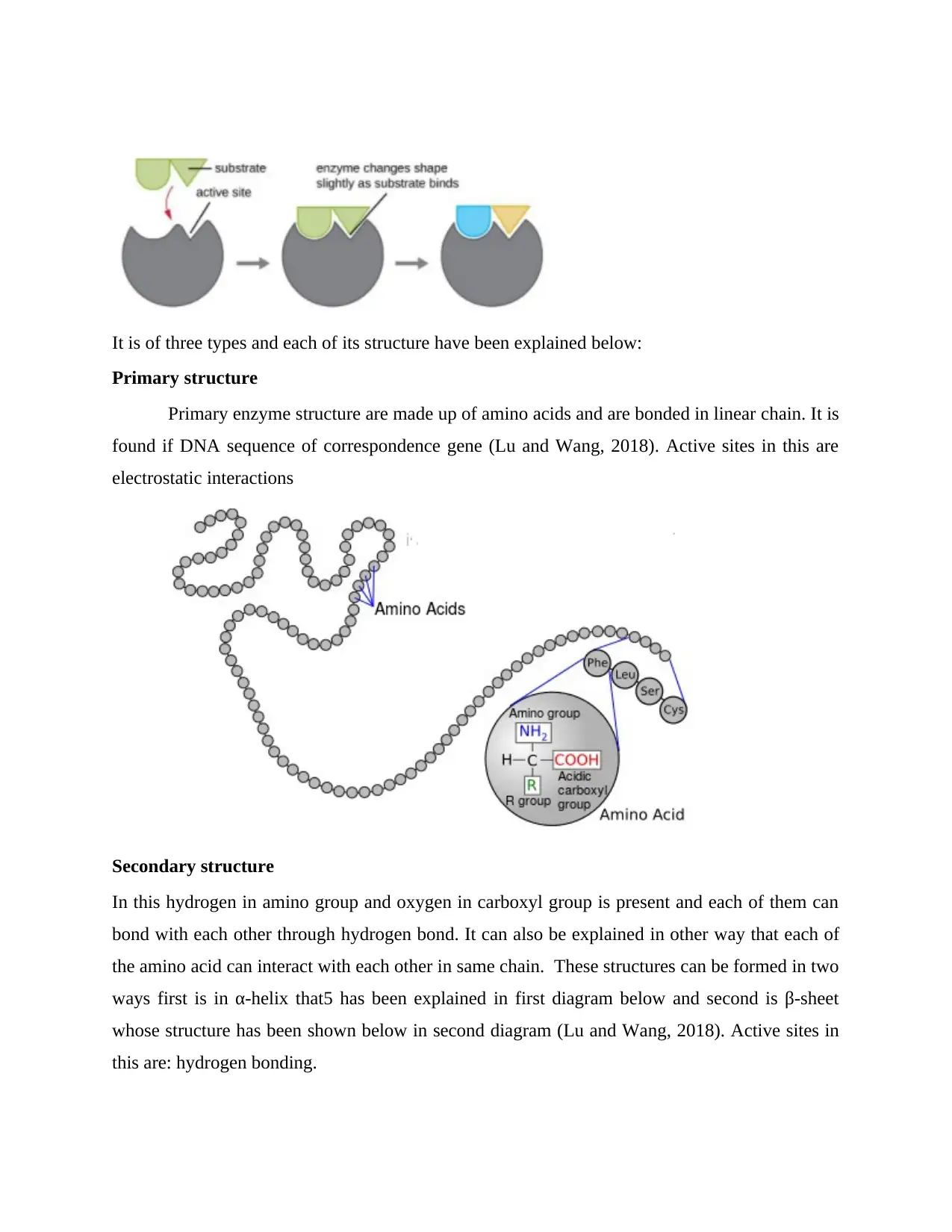
It is of three types and each of its structure have been explained below:
Primary structure
Primary enzyme structure are made up of amino acids and are bonded in linear chain. It is
found if DNA sequence of correspondence gene (Lu and Wang, 2018). Active sites in this are
electrostatic interactions
Secondary structure
In this hydrogen in amino group and oxygen in carboxyl group is present and each of them can
bond with each other through hydrogen bond. It can also be explained in other way that each of
the amino acid can interact with each other in same chain. These structures can be formed in two
ways first is in α-helix that5 has been explained in first diagram below and second is β-sheet
whose structure has been shown below in second diagram (Lu and Wang, 2018). Active sites in
this are: hydrogen bonding.
Primary structure
Primary enzyme structure are made up of amino acids and are bonded in linear chain. It is
found if DNA sequence of correspondence gene (Lu and Wang, 2018). Active sites in this are
electrostatic interactions
Secondary structure
In this hydrogen in amino group and oxygen in carboxyl group is present and each of them can
bond with each other through hydrogen bond. It can also be explained in other way that each of
the amino acid can interact with each other in same chain. These structures can be formed in two
ways first is in α-helix that5 has been explained in first diagram below and second is β-sheet
whose structure has been shown below in second diagram (Lu and Wang, 2018). Active sites in
this are: hydrogen bonding.
Secure Best Marks with AI Grader
Need help grading? Try our AI Grader for instant feedback on your assignments.
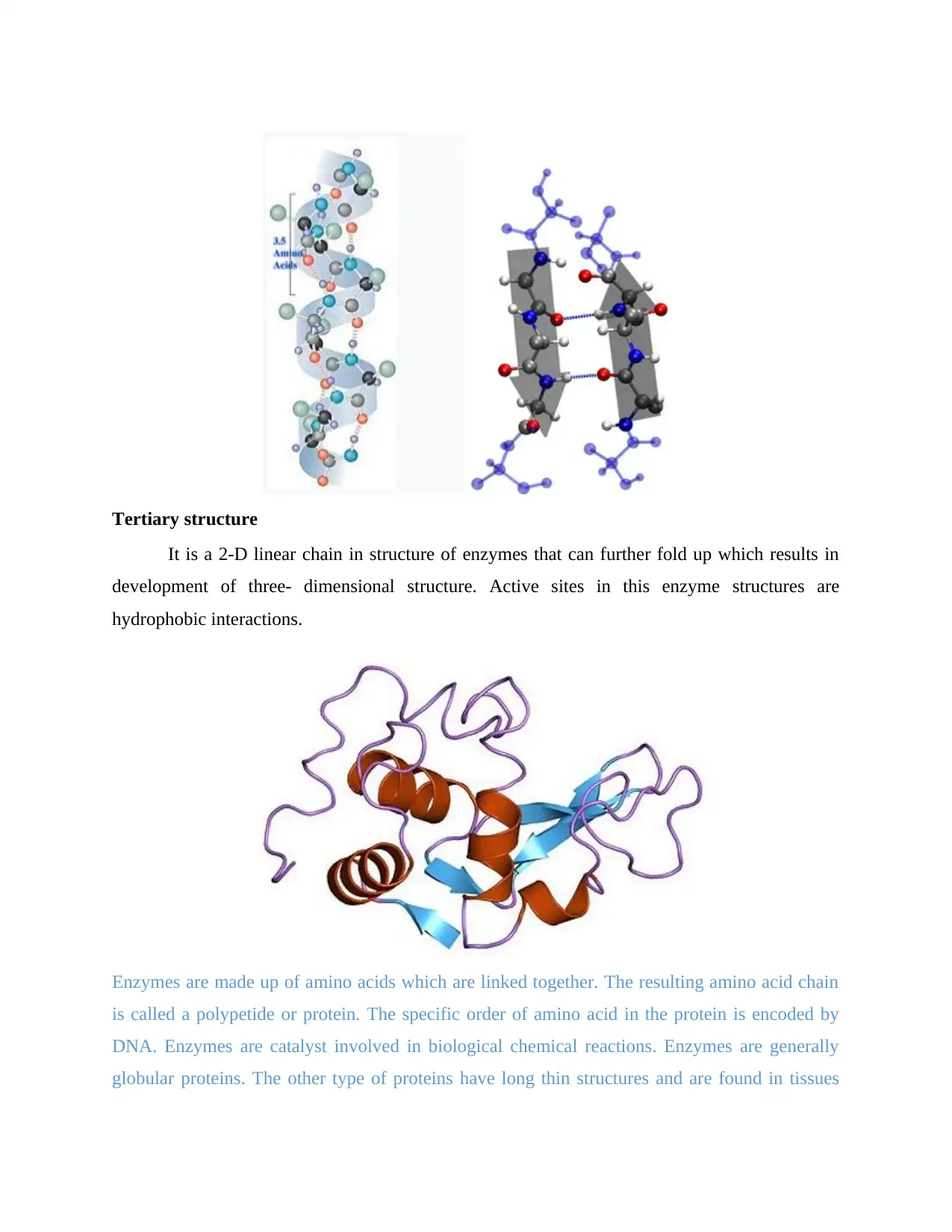
Tertiary structure
It is a 2-D linear chain in structure of enzymes that can further fold up which results in
development of three- dimensional structure. Active sites in this enzyme structures are
hydrophobic interactions.
Enzymes are made up of amino acids which are linked together. The resulting amino acid chain
is called a polypetide or protein. The specific order of amino acid in the protein is encoded by
DNA. Enzymes are catalyst involved in biological chemical reactions. Enzymes are generally
globular proteins. The other type of proteins have long thin structures and are found in tissues
It is a 2-D linear chain in structure of enzymes that can further fold up which results in
development of three- dimensional structure. Active sites in this enzyme structures are
hydrophobic interactions.
Enzymes are made up of amino acids which are linked together. The resulting amino acid chain
is called a polypetide or protein. The specific order of amino acid in the protein is encoded by
DNA. Enzymes are catalyst involved in biological chemical reactions. Enzymes are generally
globular proteins. The other type of proteins have long thin structures and are found in tissues
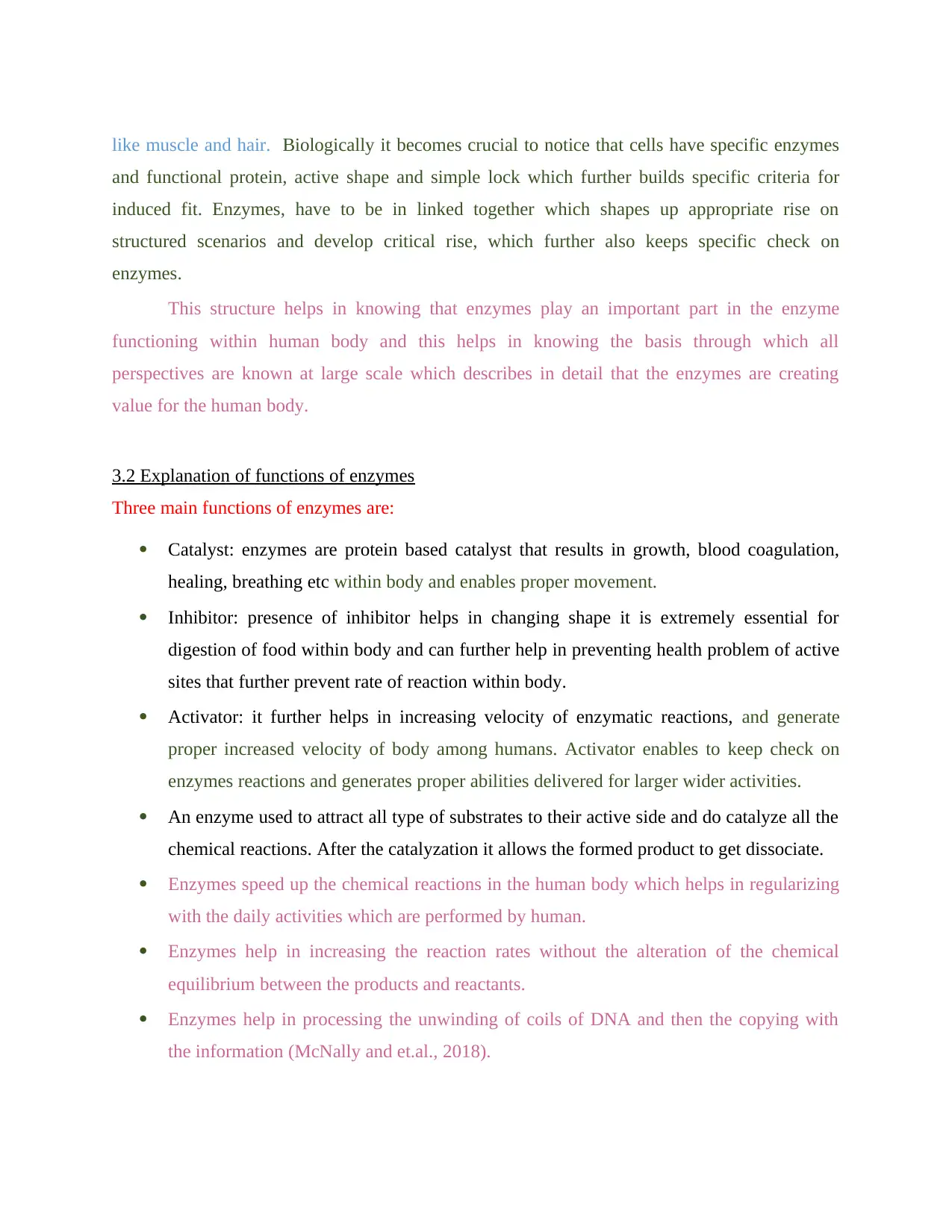
like muscle and hair. Biologically it becomes crucial to notice that cells have specific enzymes
and functional protein, active shape and simple lock which further builds specific criteria for
induced fit. Enzymes, have to be in linked together which shapes up appropriate rise on
structured scenarios and develop critical rise, which further also keeps specific check on
enzymes.
This structure helps in knowing that enzymes play an important part in the enzyme
functioning within human body and this helps in knowing the basis through which all
perspectives are known at large scale which describes in detail that the enzymes are creating
value for the human body.
3.2 Explanation of functions of enzymes
Three main functions of enzymes are:
Catalyst: enzymes are protein based catalyst that results in growth, blood coagulation,
healing, breathing etc within body and enables proper movement.
Inhibitor: presence of inhibitor helps in changing shape it is extremely essential for
digestion of food within body and can further help in preventing health problem of active
sites that further prevent rate of reaction within body.
Activator: it further helps in increasing velocity of enzymatic reactions, and generate
proper increased velocity of body among humans. Activator enables to keep check on
enzymes reactions and generates proper abilities delivered for larger wider activities.
An enzyme used to attract all type of substrates to their active side and do catalyze all the
chemical reactions. After the catalyzation it allows the formed product to get dissociate.
Enzymes speed up the chemical reactions in the human body which helps in regularizing
with the daily activities which are performed by human.
Enzymes help in increasing the reaction rates without the alteration of the chemical
equilibrium between the products and reactants.
Enzymes help in processing the unwinding of coils of DNA and then the copying with
the information (McNally and et.al., 2018).
and functional protein, active shape and simple lock which further builds specific criteria for
induced fit. Enzymes, have to be in linked together which shapes up appropriate rise on
structured scenarios and develop critical rise, which further also keeps specific check on
enzymes.
This structure helps in knowing that enzymes play an important part in the enzyme
functioning within human body and this helps in knowing the basis through which all
perspectives are known at large scale which describes in detail that the enzymes are creating
value for the human body.
3.2 Explanation of functions of enzymes
Three main functions of enzymes are:
Catalyst: enzymes are protein based catalyst that results in growth, blood coagulation,
healing, breathing etc within body and enables proper movement.
Inhibitor: presence of inhibitor helps in changing shape it is extremely essential for
digestion of food within body and can further help in preventing health problem of active
sites that further prevent rate of reaction within body.
Activator: it further helps in increasing velocity of enzymatic reactions, and generate
proper increased velocity of body among humans. Activator enables to keep check on
enzymes reactions and generates proper abilities delivered for larger wider activities.
An enzyme used to attract all type of substrates to their active side and do catalyze all the
chemical reactions. After the catalyzation it allows the formed product to get dissociate.
Enzymes speed up the chemical reactions in the human body which helps in regularizing
with the daily activities which are performed by human.
Enzymes help in increasing the reaction rates without the alteration of the chemical
equilibrium between the products and reactants.
Enzymes help in processing the unwinding of coils of DNA and then the copying with
the information (McNally and et.al., 2018).
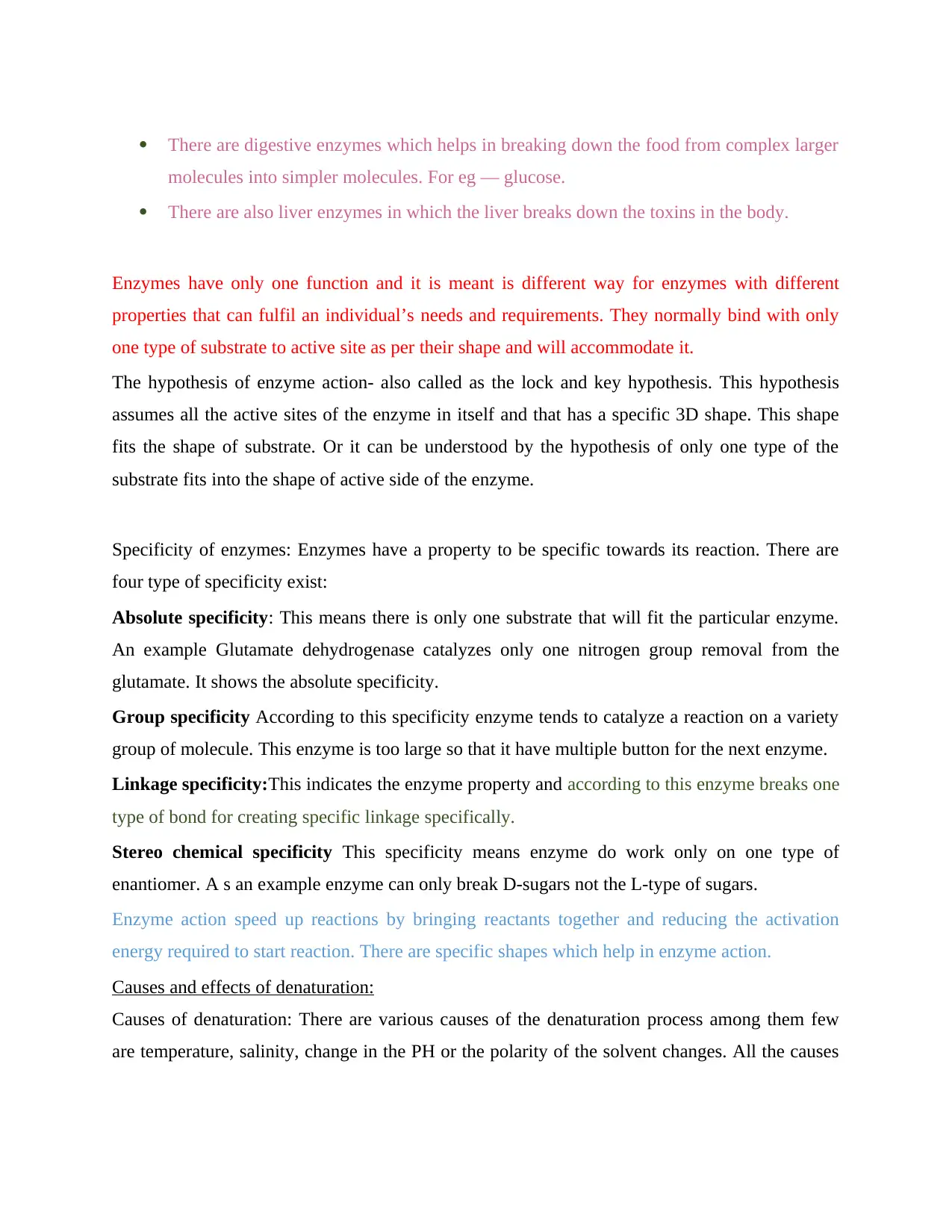
There are digestive enzymes which helps in breaking down the food from complex larger
molecules into simpler molecules. For eg — glucose.
There are also liver enzymes in which the liver breaks down the toxins in the body.
Enzymes have only one function and it is meant is different way for enzymes with different
properties that can fulfil an individual’s needs and requirements. They normally bind with only
one type of substrate to active site as per their shape and will accommodate it.
The hypothesis of enzyme action- also called as the lock and key hypothesis. This hypothesis
assumes all the active sites of the enzyme in itself and that has a specific 3D shape. This shape
fits the shape of substrate. Or it can be understood by the hypothesis of only one type of the
substrate fits into the shape of active side of the enzyme.
Specificity of enzymes: Enzymes have a property to be specific towards its reaction. There are
four type of specificity exist:
Absolute specificity: This means there is only one substrate that will fit the particular enzyme.
An example Glutamate dehydrogenase catalyzes only one nitrogen group removal from the
glutamate. It shows the absolute specificity.
Group specificity According to this specificity enzyme tends to catalyze a reaction on a variety
group of molecule. This enzyme is too large so that it have multiple button for the next enzyme.
Linkage specificity:This indicates the enzyme property and according to this enzyme breaks one
type of bond for creating specific linkage specifically.
Stereo chemical specificity This specificity means enzyme do work only on one type of
enantiomer. A s an example enzyme can only break D-sugars not the L-type of sugars.
Enzyme action speed up reactions by bringing reactants together and reducing the activation
energy required to start reaction. There are specific shapes which help in enzyme action.
Causes and effects of denaturation:
Causes of denaturation: There are various causes of the denaturation process among them few
are temperature, salinity, change in the PH or the polarity of the solvent changes. All the causes
molecules into simpler molecules. For eg — glucose.
There are also liver enzymes in which the liver breaks down the toxins in the body.
Enzymes have only one function and it is meant is different way for enzymes with different
properties that can fulfil an individual’s needs and requirements. They normally bind with only
one type of substrate to active site as per their shape and will accommodate it.
The hypothesis of enzyme action- also called as the lock and key hypothesis. This hypothesis
assumes all the active sites of the enzyme in itself and that has a specific 3D shape. This shape
fits the shape of substrate. Or it can be understood by the hypothesis of only one type of the
substrate fits into the shape of active side of the enzyme.
Specificity of enzymes: Enzymes have a property to be specific towards its reaction. There are
four type of specificity exist:
Absolute specificity: This means there is only one substrate that will fit the particular enzyme.
An example Glutamate dehydrogenase catalyzes only one nitrogen group removal from the
glutamate. It shows the absolute specificity.
Group specificity According to this specificity enzyme tends to catalyze a reaction on a variety
group of molecule. This enzyme is too large so that it have multiple button for the next enzyme.
Linkage specificity:This indicates the enzyme property and according to this enzyme breaks one
type of bond for creating specific linkage specifically.
Stereo chemical specificity This specificity means enzyme do work only on one type of
enantiomer. A s an example enzyme can only break D-sugars not the L-type of sugars.
Enzyme action speed up reactions by bringing reactants together and reducing the activation
energy required to start reaction. There are specific shapes which help in enzyme action.
Causes and effects of denaturation:
Causes of denaturation: There are various causes of the denaturation process among them few
are temperature, salinity, change in the PH or the polarity of the solvent changes. All the causes
Paraphrase This Document
Need a fresh take? Get an instant paraphrase of this document with our AI Paraphraser
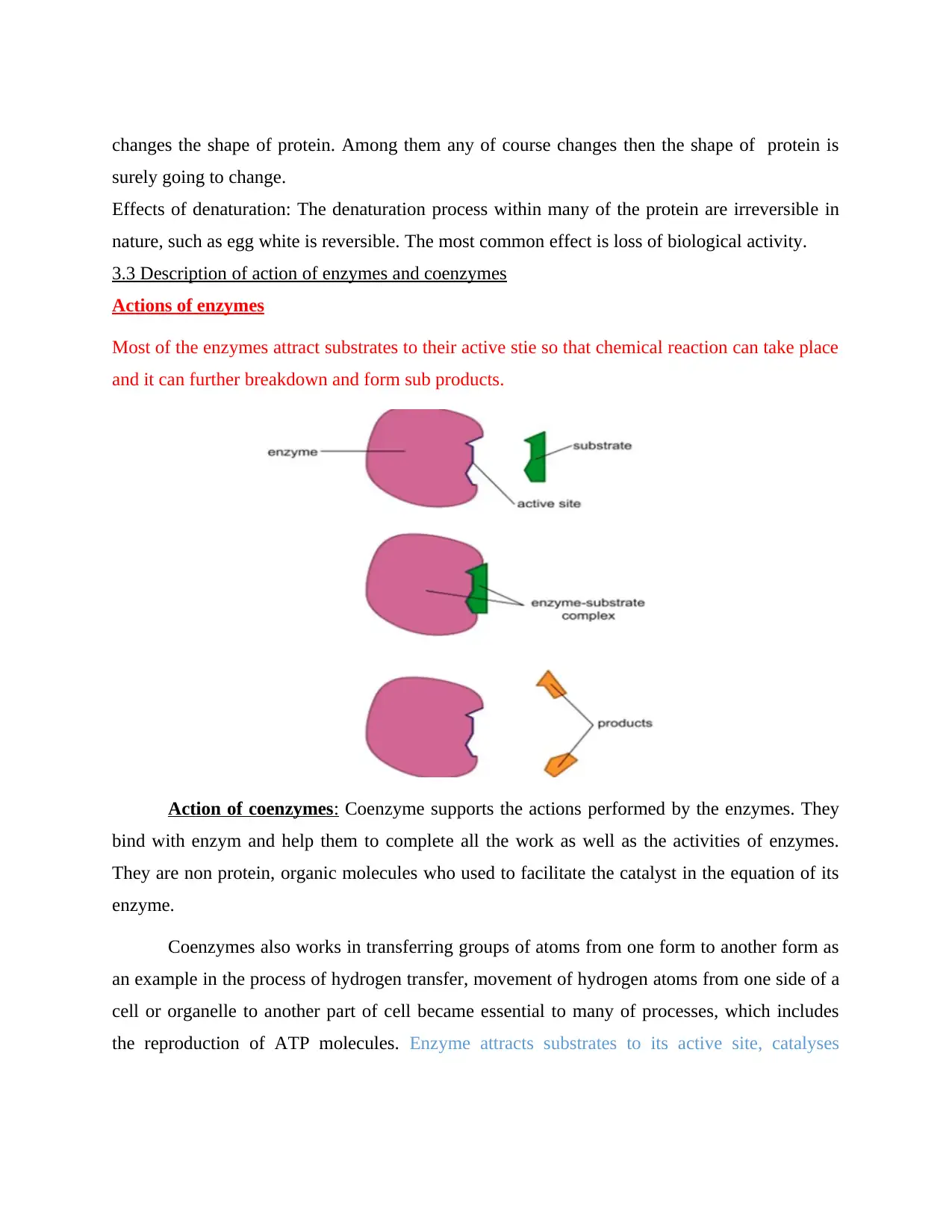
changes the shape of protein. Among them any of course changes then the shape of protein is
surely going to change.
Effects of denaturation: The denaturation process within many of the protein are irreversible in
nature, such as egg white is reversible. The most common effect is loss of biological activity.
3.3 Description of action of enzymes and coenzymes
Actions of enzymes
Most of the enzymes attract substrates to their active stie so that chemical reaction can take place
and it can further breakdown and form sub products.
Action of coenzymes: Coenzyme supports the actions performed by the enzymes. They
bind with enzym and help them to complete all the work as well as the activities of enzymes.
They are non protein, organic molecules who used to facilitate the catalyst in the equation of its
enzyme.
Coenzymes also works in transferring groups of atoms from one form to another form as
an example in the process of hydrogen transfer, movement of hydrogen atoms from one side of a
cell or organelle to another part of cell became essential to many of processes, which includes
the reproduction of ATP molecules. Enzyme attracts substrates to its active site, catalyses
surely going to change.
Effects of denaturation: The denaturation process within many of the protein are irreversible in
nature, such as egg white is reversible. The most common effect is loss of biological activity.
3.3 Description of action of enzymes and coenzymes
Actions of enzymes
Most of the enzymes attract substrates to their active stie so that chemical reaction can take place
and it can further breakdown and form sub products.
Action of coenzymes: Coenzyme supports the actions performed by the enzymes. They
bind with enzym and help them to complete all the work as well as the activities of enzymes.
They are non protein, organic molecules who used to facilitate the catalyst in the equation of its
enzyme.
Coenzymes also works in transferring groups of atoms from one form to another form as
an example in the process of hydrogen transfer, movement of hydrogen atoms from one side of a
cell or organelle to another part of cell became essential to many of processes, which includes
the reproduction of ATP molecules. Enzyme attracts substrates to its active site, catalyses
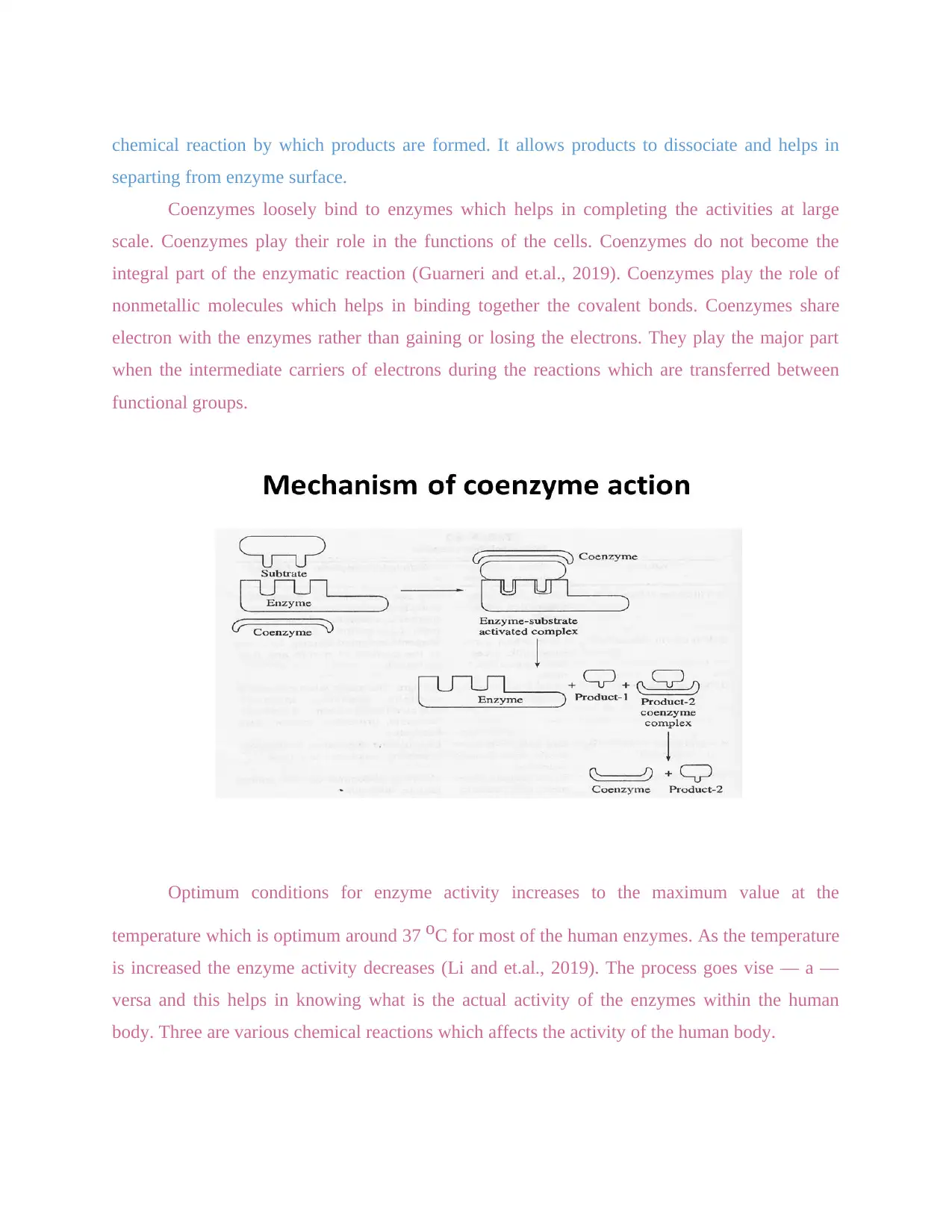
chemical reaction by which products are formed. It allows products to dissociate and helps in
separting from enzyme surface.
Coenzymes loosely bind to enzymes which helps in completing the activities at large
scale. Coenzymes play their role in the functions of the cells. Coenzymes do not become the
integral part of the enzymatic reaction (Guarneri and et.al., 2019). Coenzymes play the role of
nonmetallic molecules which helps in binding together the covalent bonds. Coenzymes share
electron with the enzymes rather than gaining or losing the electrons. They play the major part
when the intermediate carriers of electrons during the reactions which are transferred between
functional groups.
Optimum conditions for enzyme activity increases to the maximum value at the
temperature which is optimum around 37 oC for most of the human enzymes. As the temperature
is increased the enzyme activity decreases (Li and et.al., 2019). The process goes vise — a —
versa and this helps in knowing what is the actual activity of the enzymes within the human
body. Three are various chemical reactions which affects the activity of the human body.
separting from enzyme surface.
Coenzymes loosely bind to enzymes which helps in completing the activities at large
scale. Coenzymes play their role in the functions of the cells. Coenzymes do not become the
integral part of the enzymatic reaction (Guarneri and et.al., 2019). Coenzymes play the role of
nonmetallic molecules which helps in binding together the covalent bonds. Coenzymes share
electron with the enzymes rather than gaining or losing the electrons. They play the major part
when the intermediate carriers of electrons during the reactions which are transferred between
functional groups.
Optimum conditions for enzyme activity increases to the maximum value at the
temperature which is optimum around 37 oC for most of the human enzymes. As the temperature
is increased the enzyme activity decreases (Li and et.al., 2019). The process goes vise — a —
versa and this helps in knowing what is the actual activity of the enzymes within the human
body. Three are various chemical reactions which affects the activity of the human body.
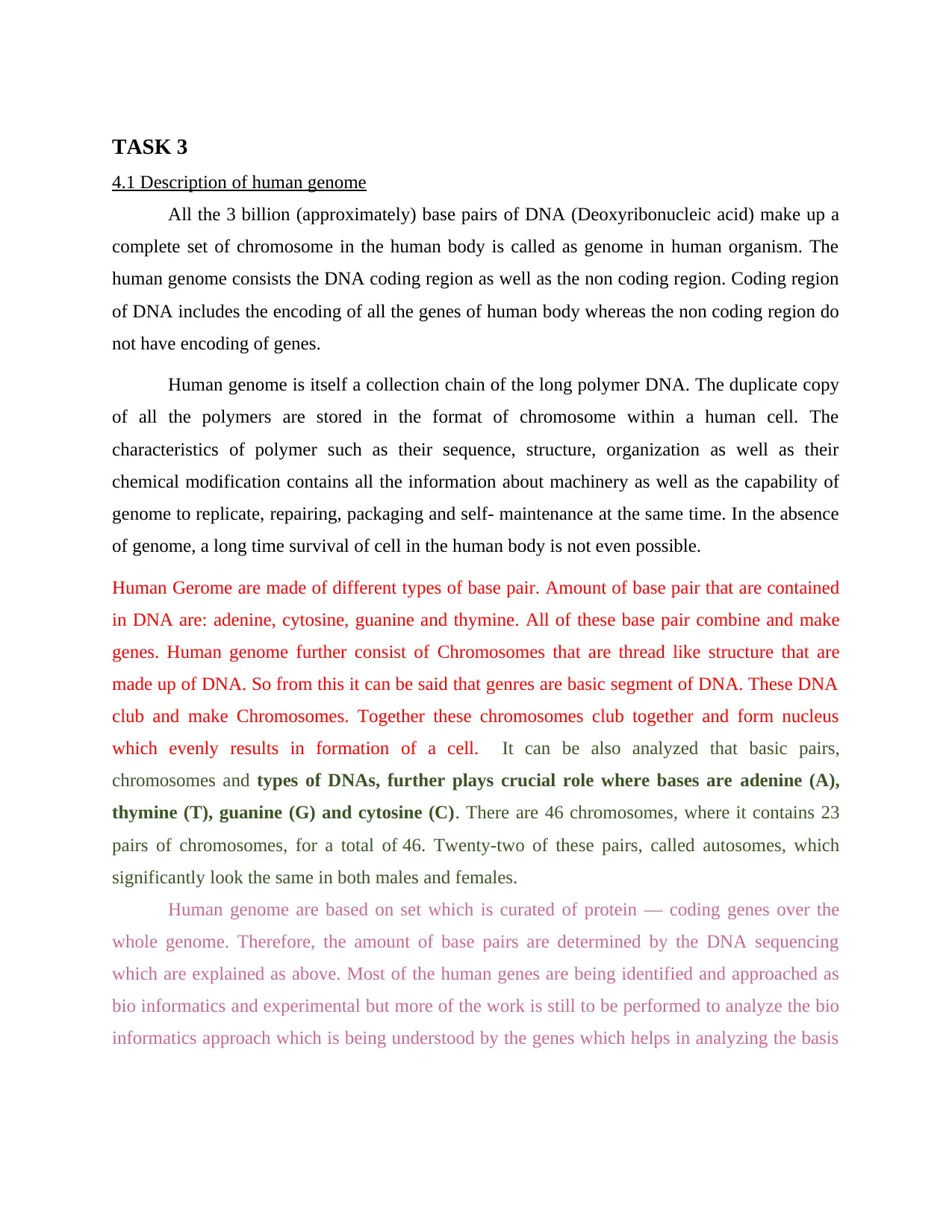
TASK 3
4.1 Description of human genome
All the 3 billion (approximately) base pairs of DNA (Deoxyribonucleic acid) make up a
complete set of chromosome in the human body is called as genome in human organism. The
human genome consists the DNA coding region as well as the non coding region. Coding region
of DNA includes the encoding of all the genes of human body whereas the non coding region do
not have encoding of genes.
Human genome is itself a collection chain of the long polymer DNA. The duplicate copy
of all the polymers are stored in the format of chromosome within a human cell. The
characteristics of polymer such as their sequence, structure, organization as well as their
chemical modification contains all the information about machinery as well as the capability of
genome to replicate, repairing, packaging and self- maintenance at the same time. In the absence
of genome, a long time survival of cell in the human body is not even possible.
Human Gerome are made of different types of base pair. Amount of base pair that are contained
in DNA are: adenine, cytosine, guanine and thymine. All of these base pair combine and make
genes. Human genome further consist of Chromosomes that are thread like structure that are
made up of DNA. So from this it can be said that genres are basic segment of DNA. These DNA
club and make Chromosomes. Together these chromosomes club together and form nucleus
which evenly results in formation of a cell. It can be also analyzed that basic pairs,
chromosomes and types of DNAs, further plays crucial role where bases are adenine (A),
thymine (T), guanine (G) and cytosine (C). There are 46 chromosomes, where it contains 23
pairs of chromosomes, for a total of 46. Twenty-two of these pairs, called autosomes, which
significantly look the same in both males and females.
Human genome are based on set which is curated of protein — coding genes over the
whole genome. Therefore, the amount of base pairs are determined by the DNA sequencing
which are explained as above. Most of the human genes are being identified and approached as
bio informatics and experimental but more of the work is still to be performed to analyze the bio
informatics approach which is being understood by the genes which helps in analyzing the basis
4.1 Description of human genome
All the 3 billion (approximately) base pairs of DNA (Deoxyribonucleic acid) make up a
complete set of chromosome in the human body is called as genome in human organism. The
human genome consists the DNA coding region as well as the non coding region. Coding region
of DNA includes the encoding of all the genes of human body whereas the non coding region do
not have encoding of genes.
Human genome is itself a collection chain of the long polymer DNA. The duplicate copy
of all the polymers are stored in the format of chromosome within a human cell. The
characteristics of polymer such as their sequence, structure, organization as well as their
chemical modification contains all the information about machinery as well as the capability of
genome to replicate, repairing, packaging and self- maintenance at the same time. In the absence
of genome, a long time survival of cell in the human body is not even possible.
Human Gerome are made of different types of base pair. Amount of base pair that are contained
in DNA are: adenine, cytosine, guanine and thymine. All of these base pair combine and make
genes. Human genome further consist of Chromosomes that are thread like structure that are
made up of DNA. So from this it can be said that genres are basic segment of DNA. These DNA
club and make Chromosomes. Together these chromosomes club together and form nucleus
which evenly results in formation of a cell. It can be also analyzed that basic pairs,
chromosomes and types of DNAs, further plays crucial role where bases are adenine (A),
thymine (T), guanine (G) and cytosine (C). There are 46 chromosomes, where it contains 23
pairs of chromosomes, for a total of 46. Twenty-two of these pairs, called autosomes, which
significantly look the same in both males and females.
Human genome are based on set which is curated of protein — coding genes over the
whole genome. Therefore, the amount of base pairs are determined by the DNA sequencing
which are explained as above. Most of the human genes are being identified and approached as
bio informatics and experimental but more of the work is still to be performed to analyze the bio
informatics approach which is being understood by the genes which helps in analyzing the basis
Secure Best Marks with AI Grader
Need help grading? Try our AI Grader for instant feedback on your assignments.
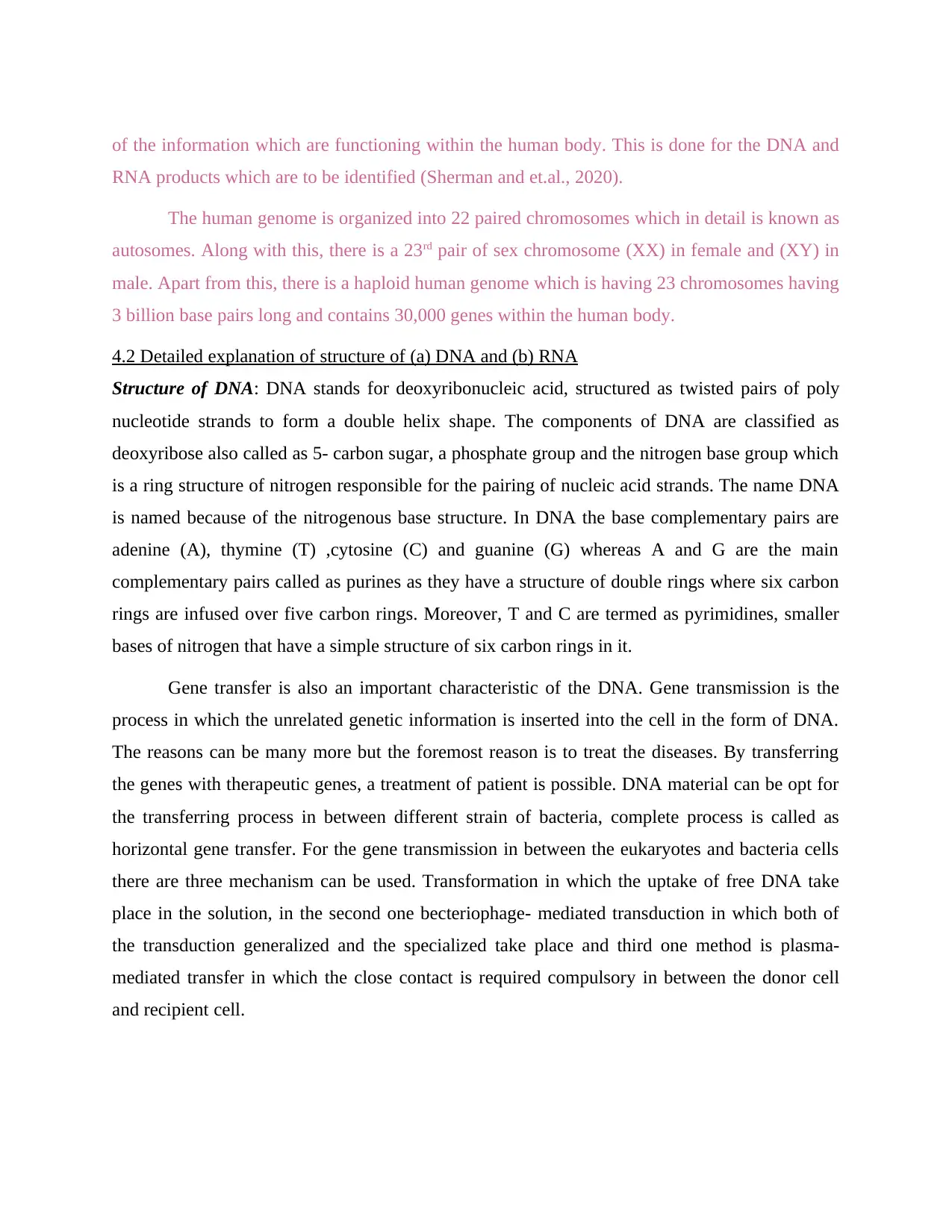
of the information which are functioning within the human body. This is done for the DNA and
RNA products which are to be identified (Sherman and et.al., 2020).
The human genome is organized into 22 paired chromosomes which in detail is known as
autosomes. Along with this, there is a 23rd pair of sex chromosome (XX) in female and (XY) in
male. Apart from this, there is a haploid human genome which is having 23 chromosomes having
3 billion base pairs long and contains 30,000 genes within the human body.
4.2 Detailed explanation of structure of (a) DNA and (b) RNA
Structure of DNA: DNA stands for deoxyribonucleic acid, structured as twisted pairs of poly
nucleotide strands to form a double helix shape. The components of DNA are classified as
deoxyribose also called as 5- carbon sugar, a phosphate group and the nitrogen base group which
is a ring structure of nitrogen responsible for the pairing of nucleic acid strands. The name DNA
is named because of the nitrogenous base structure. In DNA the base complementary pairs are
adenine (A), thymine (T) ,cytosine (C) and guanine (G) whereas A and G are the main
complementary pairs called as purines as they have a structure of double rings where six carbon
rings are infused over five carbon rings. Moreover, T and C are termed as pyrimidines, smaller
bases of nitrogen that have a simple structure of six carbon rings in it.
Gene transfer is also an important characteristic of the DNA. Gene transmission is the
process in which the unrelated genetic information is inserted into the cell in the form of DNA.
The reasons can be many more but the foremost reason is to treat the diseases. By transferring
the genes with therapeutic genes, a treatment of patient is possible. DNA material can be opt for
the transferring process in between different strain of bacteria, complete process is called as
horizontal gene transfer. For the gene transmission in between the eukaryotes and bacteria cells
there are three mechanism can be used. Transformation in which the uptake of free DNA take
place in the solution, in the second one becteriophage- mediated transduction in which both of
the transduction generalized and the specialized take place and third one method is plasma-
mediated transfer in which the close contact is required compulsory in between the donor cell
and recipient cell.
RNA products which are to be identified (Sherman and et.al., 2020).
The human genome is organized into 22 paired chromosomes which in detail is known as
autosomes. Along with this, there is a 23rd pair of sex chromosome (XX) in female and (XY) in
male. Apart from this, there is a haploid human genome which is having 23 chromosomes having
3 billion base pairs long and contains 30,000 genes within the human body.
4.2 Detailed explanation of structure of (a) DNA and (b) RNA
Structure of DNA: DNA stands for deoxyribonucleic acid, structured as twisted pairs of poly
nucleotide strands to form a double helix shape. The components of DNA are classified as
deoxyribose also called as 5- carbon sugar, a phosphate group and the nitrogen base group which
is a ring structure of nitrogen responsible for the pairing of nucleic acid strands. The name DNA
is named because of the nitrogenous base structure. In DNA the base complementary pairs are
adenine (A), thymine (T) ,cytosine (C) and guanine (G) whereas A and G are the main
complementary pairs called as purines as they have a structure of double rings where six carbon
rings are infused over five carbon rings. Moreover, T and C are termed as pyrimidines, smaller
bases of nitrogen that have a simple structure of six carbon rings in it.
Gene transfer is also an important characteristic of the DNA. Gene transmission is the
process in which the unrelated genetic information is inserted into the cell in the form of DNA.
The reasons can be many more but the foremost reason is to treat the diseases. By transferring
the genes with therapeutic genes, a treatment of patient is possible. DNA material can be opt for
the transferring process in between different strain of bacteria, complete process is called as
horizontal gene transfer. For the gene transmission in between the eukaryotes and bacteria cells
there are three mechanism can be used. Transformation in which the uptake of free DNA take
place in the solution, in the second one becteriophage- mediated transduction in which both of
the transduction generalized and the specialized take place and third one method is plasma-
mediated transfer in which the close contact is required compulsory in between the donor cell
and recipient cell.
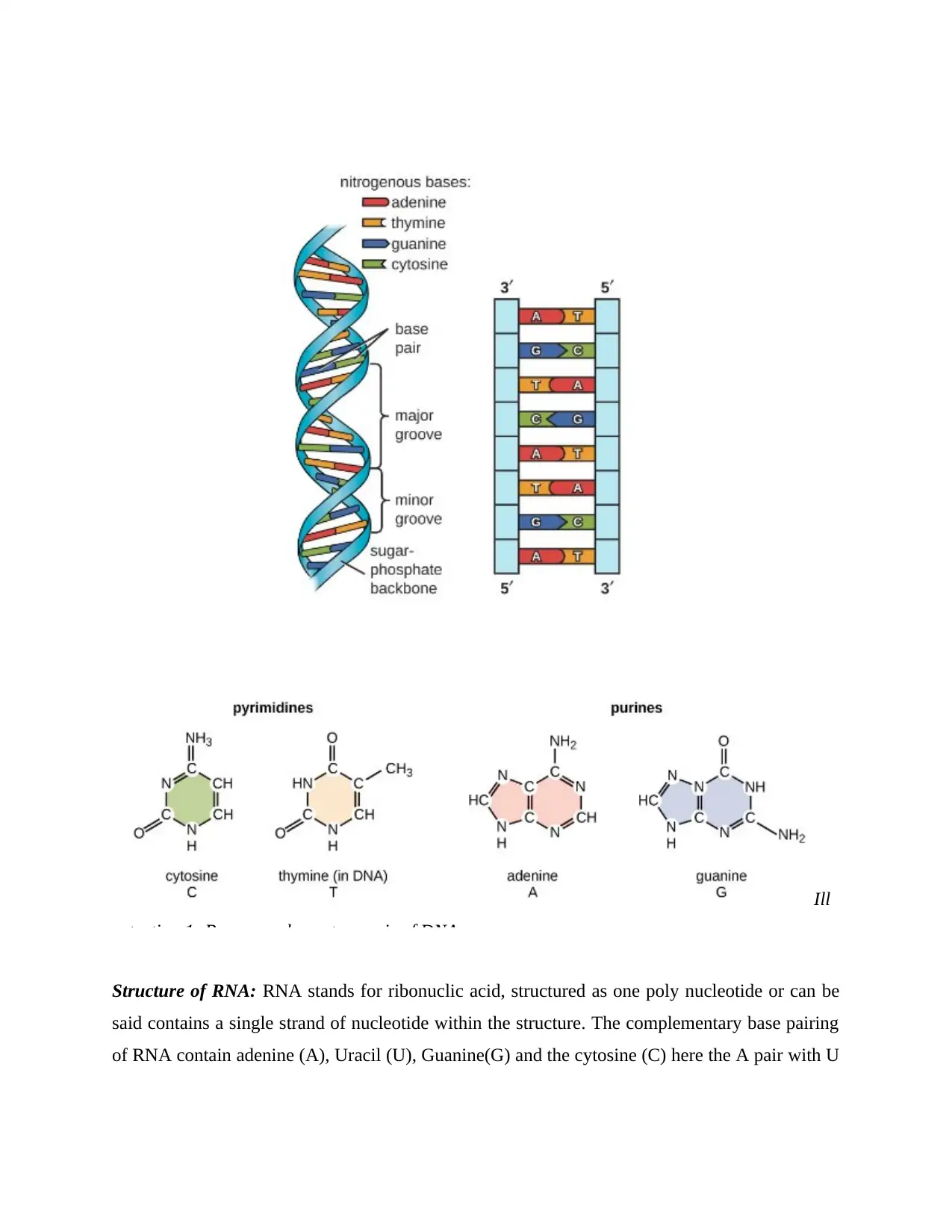
Structure of RNA: RNA stands for ribonuclic acid, structured as one poly nucleotide or can be
said contains a single strand of nucleotide within the structure. The complementary base pairing
of RNA contain adenine (A), Uracil (U), Guanine(G) and the cytosine (C) here the A pair with U
Ill
ustration 1: Base complementory pair of DNA
said contains a single strand of nucleotide within the structure. The complementary base pairing
of RNA contain adenine (A), Uracil (U), Guanine(G) and the cytosine (C) here the A pair with U
Ill
ustration 1: Base complementory pair of DNA

and G pairs with C. Each RNA strand have a basic structure, that includes nitrogenous bases
bounded with the sugar phospjhate backbone. A,U,G,C are the four nitrogenous bases of RNA.
4.3 Explanation of functions of nucleic acids
Storage and transmission of genetic information, role of DNA and RNA in protein
synthesis through transcription and translation
The functions of nucleic acids are related to the storage as well as the expression behind
the genetic information. DNA encodes the information required by cell related to the protein
production or formation whereas RNA participates in the process of protein synthesis in the
molecular form. Genetic information is always stored in the nucleic acid chains. Base pairing
results in the double helix formation or DNA. Here the genetic information is being copied from
bounded with the sugar phospjhate backbone. A,U,G,C are the four nitrogenous bases of RNA.
4.3 Explanation of functions of nucleic acids
Storage and transmission of genetic information, role of DNA and RNA in protein
synthesis through transcription and translation
The functions of nucleic acids are related to the storage as well as the expression behind
the genetic information. DNA encodes the information required by cell related to the protein
production or formation whereas RNA participates in the process of protein synthesis in the
molecular form. Genetic information is always stored in the nucleic acid chains. Base pairing
results in the double helix formation or DNA. Here the genetic information is being copied from
Paraphrase This Document
Need a fresh take? Get an instant paraphrase of this document with our AI Paraphraser
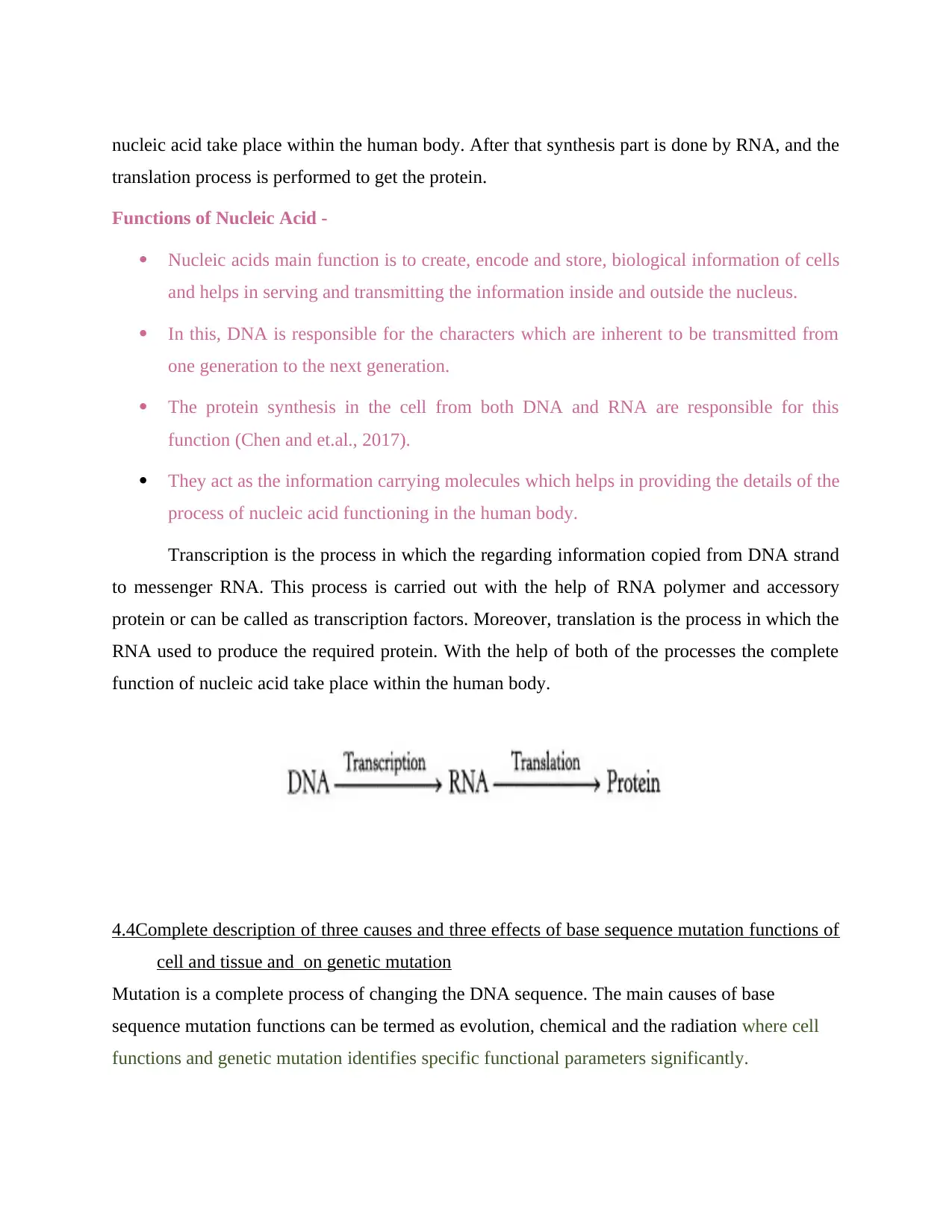
nucleic acid take place within the human body. After that synthesis part is done by RNA, and the
translation process is performed to get the protein.
Functions of Nucleic Acid -
Nucleic acids main function is to create, encode and store, biological information of cells
and helps in serving and transmitting the information inside and outside the nucleus.
In this, DNA is responsible for the characters which are inherent to be transmitted from
one generation to the next generation.
The protein synthesis in the cell from both DNA and RNA are responsible for this
function (Chen and et.al., 2017).
They act as the information carrying molecules which helps in providing the details of the
process of nucleic acid functioning in the human body.
Transcription is the process in which the regarding information copied from DNA strand
to messenger RNA. This process is carried out with the help of RNA polymer and accessory
protein or can be called as transcription factors. Moreover, translation is the process in which the
RNA used to produce the required protein. With the help of both of the processes the complete
function of nucleic acid take place within the human body.
4.4Complete description of three causes and three effects of base sequence mutation functions of
cell and tissue and on genetic mutation
Mutation is a complete process of changing the DNA sequence. The main causes of base
sequence mutation functions can be termed as evolution, chemical and the radiation where cell
functions and genetic mutation identifies specific functional parameters significantly.
translation process is performed to get the protein.
Functions of Nucleic Acid -
Nucleic acids main function is to create, encode and store, biological information of cells
and helps in serving and transmitting the information inside and outside the nucleus.
In this, DNA is responsible for the characters which are inherent to be transmitted from
one generation to the next generation.
The protein synthesis in the cell from both DNA and RNA are responsible for this
function (Chen and et.al., 2017).
They act as the information carrying molecules which helps in providing the details of the
process of nucleic acid functioning in the human body.
Transcription is the process in which the regarding information copied from DNA strand
to messenger RNA. This process is carried out with the help of RNA polymer and accessory
protein or can be called as transcription factors. Moreover, translation is the process in which the
RNA used to produce the required protein. With the help of both of the processes the complete
function of nucleic acid take place within the human body.
4.4Complete description of three causes and three effects of base sequence mutation functions of
cell and tissue and on genetic mutation
Mutation is a complete process of changing the DNA sequence. The main causes of base
sequence mutation functions can be termed as evolution, chemical and the radiation where cell
functions and genetic mutation identifies specific functional parameters significantly.
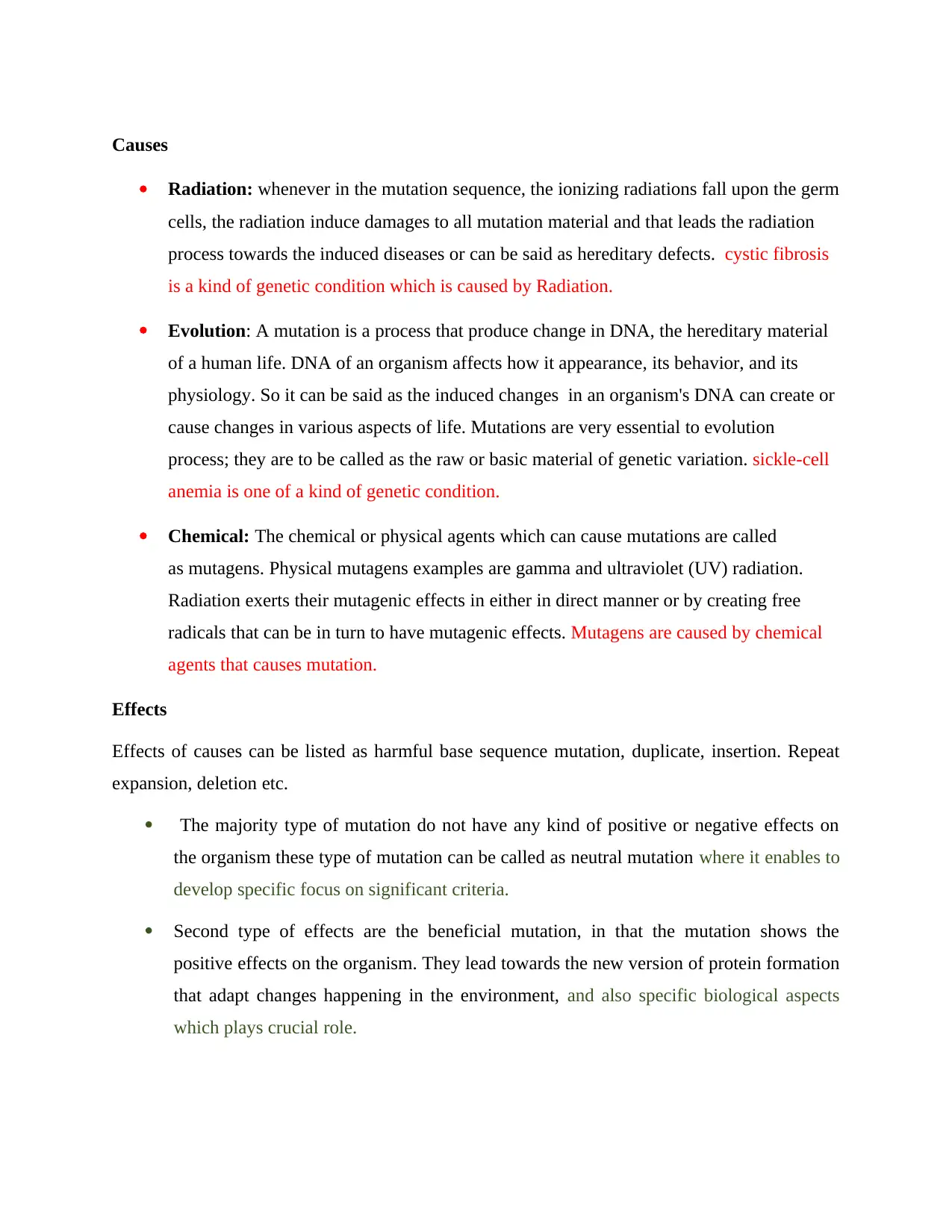
Causes
Radiation: whenever in the mutation sequence, the ionizing radiations fall upon the germ
cells, the radiation induce damages to all mutation material and that leads the radiation
process towards the induced diseases or can be said as hereditary defects. cystic fibrosis
is a kind of genetic condition which is caused by Radiation.
Evolution: A mutation is a process that produce change in DNA, the hereditary material
of a human life. DNA of an organism affects how it appearance, its behavior, and its
physiology. So it can be said as the induced changes in an organism's DNA can create or
cause changes in various aspects of life. Mutations are very essential to evolution
process; they are to be called as the raw or basic material of genetic variation. sickle-cell
anemia is one of a kind of genetic condition.
Chemical: The chemical or physical agents which can cause mutations are called
as mutagens. Physical mutagens examples are gamma and ultraviolet (UV) radiation.
Radiation exerts their mutagenic effects in either in direct manner or by creating free
radicals that can be in turn to have mutagenic effects. Mutagens are caused by chemical
agents that causes mutation.
Effects
Effects of causes can be listed as harmful base sequence mutation, duplicate, insertion. Repeat
expansion, deletion etc.
The majority type of mutation do not have any kind of positive or negative effects on
the organism these type of mutation can be called as neutral mutation where it enables to
develop specific focus on significant criteria.
Second type of effects are the beneficial mutation, in that the mutation shows the
positive effects on the organism. They lead towards the new version of protein formation
that adapt changes happening in the environment, and also specific biological aspects
which plays crucial role.
Radiation: whenever in the mutation sequence, the ionizing radiations fall upon the germ
cells, the radiation induce damages to all mutation material and that leads the radiation
process towards the induced diseases or can be said as hereditary defects. cystic fibrosis
is a kind of genetic condition which is caused by Radiation.
Evolution: A mutation is a process that produce change in DNA, the hereditary material
of a human life. DNA of an organism affects how it appearance, its behavior, and its
physiology. So it can be said as the induced changes in an organism's DNA can create or
cause changes in various aspects of life. Mutations are very essential to evolution
process; they are to be called as the raw or basic material of genetic variation. sickle-cell
anemia is one of a kind of genetic condition.
Chemical: The chemical or physical agents which can cause mutations are called
as mutagens. Physical mutagens examples are gamma and ultraviolet (UV) radiation.
Radiation exerts their mutagenic effects in either in direct manner or by creating free
radicals that can be in turn to have mutagenic effects. Mutagens are caused by chemical
agents that causes mutation.
Effects
Effects of causes can be listed as harmful base sequence mutation, duplicate, insertion. Repeat
expansion, deletion etc.
The majority type of mutation do not have any kind of positive or negative effects on
the organism these type of mutation can be called as neutral mutation where it enables to
develop specific focus on significant criteria.
Second type of effects are the beneficial mutation, in that the mutation shows the
positive effects on the organism. They lead towards the new version of protein formation
that adapt changes happening in the environment, and also specific biological aspects
which plays crucial role.

The third one is called as harmful mutation, they are harmful for the organism. These
harms can be listed as genetic disorder, cancer etc.
harms can be listed as genetic disorder, cancer etc.
Secure Best Marks with AI Grader
Need help grading? Try our AI Grader for instant feedback on your assignments.

REFERENCES
Books and Journals
Borase, D. N., and et. al., 2020., Long-term impact of diversified crop rotations and nutrient
management practices on soil microbial functions and soil enzymes activity. Ecological
Indicators, 114. p.106322.
Chen, W.H. and et.al., 2017. Stimuli-responsive nucleic acid-functionalized metal–organic
framework nanoparticles using pH-and metal-ion-dependent DNAzymes as locks.
Chemical science.8(8).pp.5769-5780.
Delcourt, M., and et.al., 2020., Influence of Nutritional Intake of Carbohydrates on
Mitochondrial Structure, Dynamics, and Functions during
Adipogenesis. Nutrients, 12(10). p.2984.
Guarneri, A. and et.al., 2019. Alternative coenzymes for biocatalysis. Current opinion in
biotechnology.60.pp.63-71.
Hollóczki, O. and Gehrke, S., 2019., Nanoplastics can change the secondary structure of
proteins. Scientific reports, 9(1). pp.1-7.
Kanagawa, M. and Toda, T., 2018., Ribitol-phosphate—a newly identified posttranslational
glycosylation unit in mammals: structure, modification enzymes and relationship to
human diseases. The Journal of Biochemistry. 163(5). pp.359-369.
Li, J. and et.al., 2019. Bilberry anthocyanin extract promotes intestinal barrier function and
inhibits digestive enzyme activity by regulating the gut microbiota in aging rats. Food
& function.10(1).pp.333-343.
Lu, S. and Wang, Y., 2018., Nonmetabolic functions of metabolic enzymes in cancer
development. Cancer Communications. 38(1). pp.1-7.
McNally, F.J. and et.al., 2018. Microtubule-severing enzymes: From cellular functions to
molecular mechanism. Journal of Cell Biology.217(12).pp.4057-4069.
Saeed, A., and et. al., 2021., Effects of aluminum chloride and coenzyme Q10 on the molecular
structure of lipids and the morphology of the brain hippocampus cells. RSC
Advances. 11(48). pp.29925-29933.
Books and Journals
Borase, D. N., and et. al., 2020., Long-term impact of diversified crop rotations and nutrient
management practices on soil microbial functions and soil enzymes activity. Ecological
Indicators, 114. p.106322.
Chen, W.H. and et.al., 2017. Stimuli-responsive nucleic acid-functionalized metal–organic
framework nanoparticles using pH-and metal-ion-dependent DNAzymes as locks.
Chemical science.8(8).pp.5769-5780.
Delcourt, M., and et.al., 2020., Influence of Nutritional Intake of Carbohydrates on
Mitochondrial Structure, Dynamics, and Functions during
Adipogenesis. Nutrients, 12(10). p.2984.
Guarneri, A. and et.al., 2019. Alternative coenzymes for biocatalysis. Current opinion in
biotechnology.60.pp.63-71.
Hollóczki, O. and Gehrke, S., 2019., Nanoplastics can change the secondary structure of
proteins. Scientific reports, 9(1). pp.1-7.
Kanagawa, M. and Toda, T., 2018., Ribitol-phosphate—a newly identified posttranslational
glycosylation unit in mammals: structure, modification enzymes and relationship to
human diseases. The Journal of Biochemistry. 163(5). pp.359-369.
Li, J. and et.al., 2019. Bilberry anthocyanin extract promotes intestinal barrier function and
inhibits digestive enzyme activity by regulating the gut microbiota in aging rats. Food
& function.10(1).pp.333-343.
Lu, S. and Wang, Y., 2018., Nonmetabolic functions of metabolic enzymes in cancer
development. Cancer Communications. 38(1). pp.1-7.
McNally, F.J. and et.al., 2018. Microtubule-severing enzymes: From cellular functions to
molecular mechanism. Journal of Cell Biology.217(12).pp.4057-4069.
Saeed, A., and et. al., 2021., Effects of aluminum chloride and coenzyme Q10 on the molecular
structure of lipids and the morphology of the brain hippocampus cells. RSC
Advances. 11(48). pp.29925-29933.

Sherman, R.M. and et.al., 2020. Pan-genomics in the human genome era. Nature Reviews
Genetics.21(4).pp.243-254.
Genetics.21(4).pp.243-254.
1 out of 24
Related Documents
Your All-in-One AI-Powered Toolkit for Academic Success.
+13062052269
info@desklib.com
Available 24*7 on WhatsApp / Email
![[object Object]](/_next/static/media/star-bottom.7253800d.svg)
Unlock your academic potential
© 2024 | Zucol Services PVT LTD | All rights reserved.




